Warning: pic heavy, as usual. 
Reviewer's note: This is the final shipping version of the MiniMax Nova MM15 by Niwalker. This review is meant to replace the earlier first prototype and second prototype reviews. Please continue all discussion in this thread, thanks!
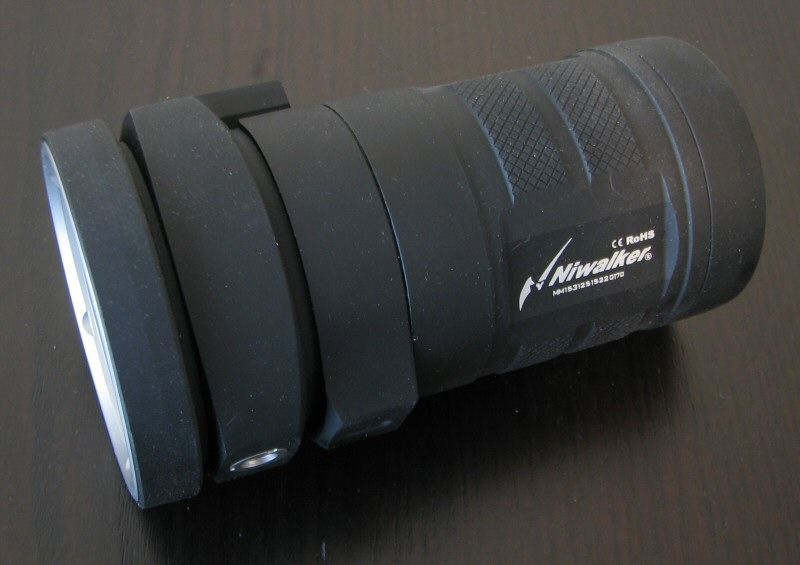
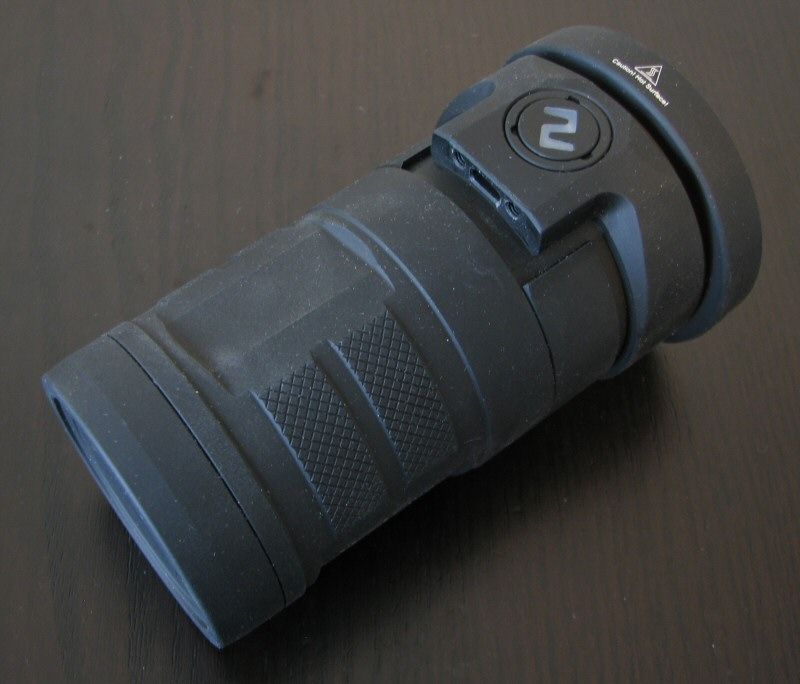
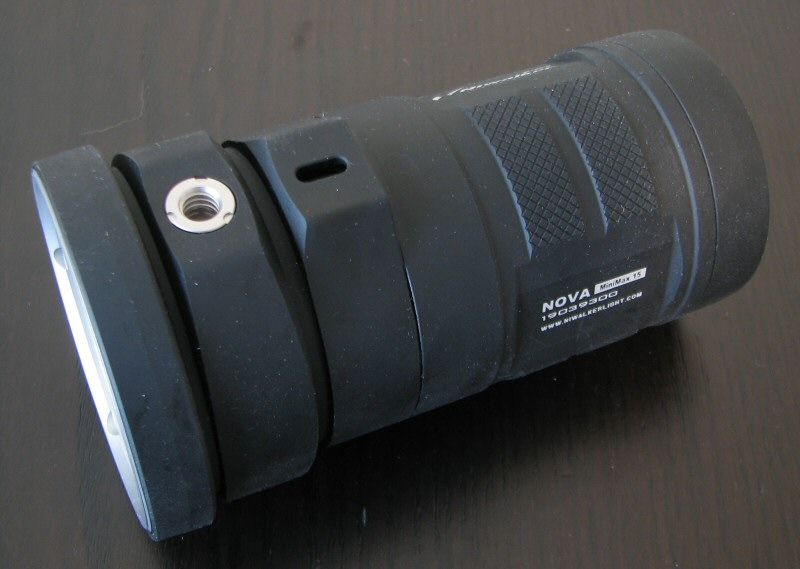
The MM15 is meant to be a "floody" style powerhouse light, in a small handhold build (2xMT-G2 emitters, powered by 4x18650). oo:
oo:
As before, there have some noticeable build changes from the previous engineering sample of the MM15. Basic design remains largely unchanged though. I will walk you through all the changes since my second prototype review, but first the official specs.
Manufacturer Reported Specifications:
(note: as always, these are simply what the manufacturer provides – scroll down to see my actual testing results).
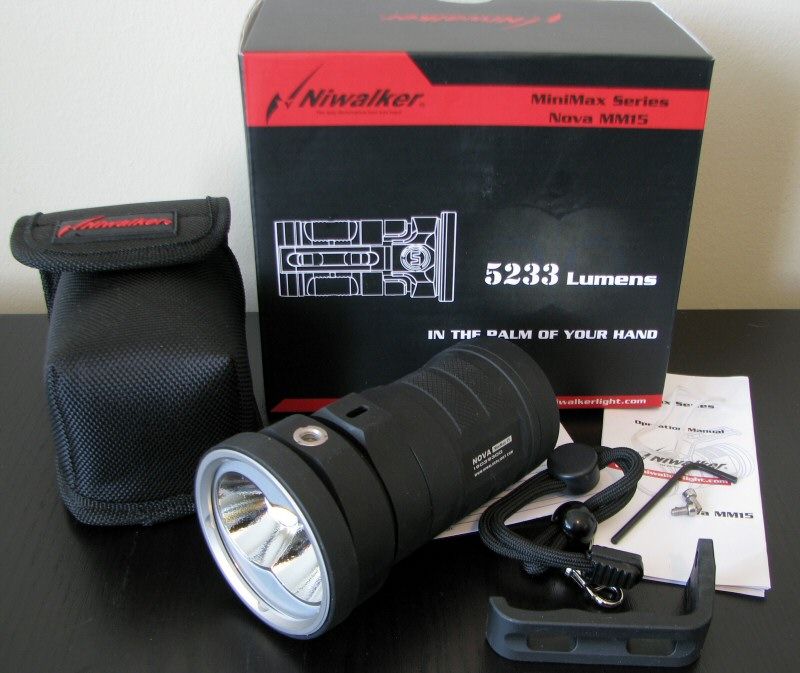
Retail packaging is similar to other recent Niwalker lights. Inside the hard cardboard box, you will find the light inside a decent quality holster (with Velcroed closing flap). The carry handle is included separately, in a cardboard holder. Also included are good quality hex-head stainless steel screws for the handle, Allen (hex) key, wrist lanyard, extra o-ring, warranty card and manual.
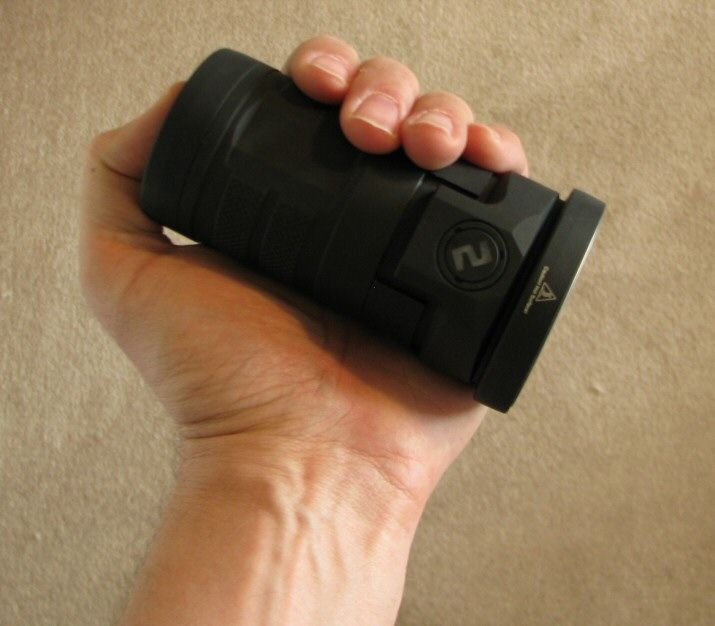
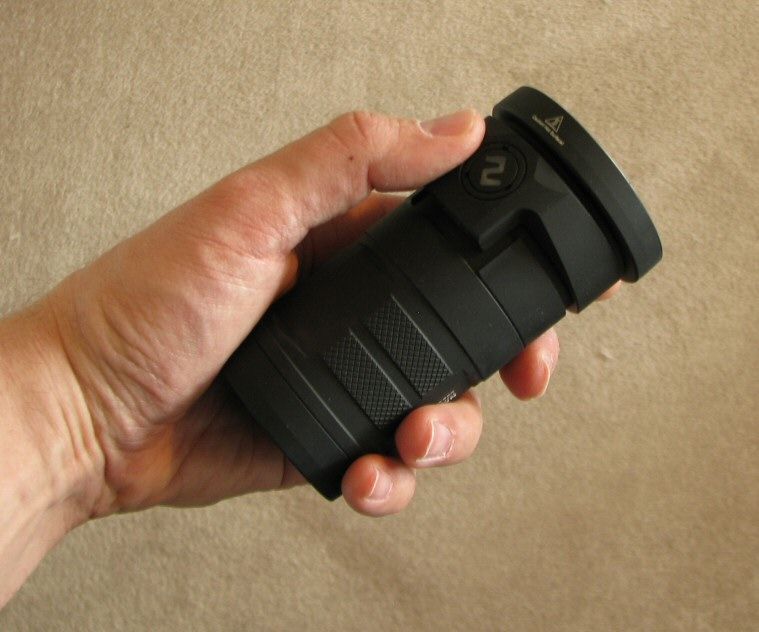
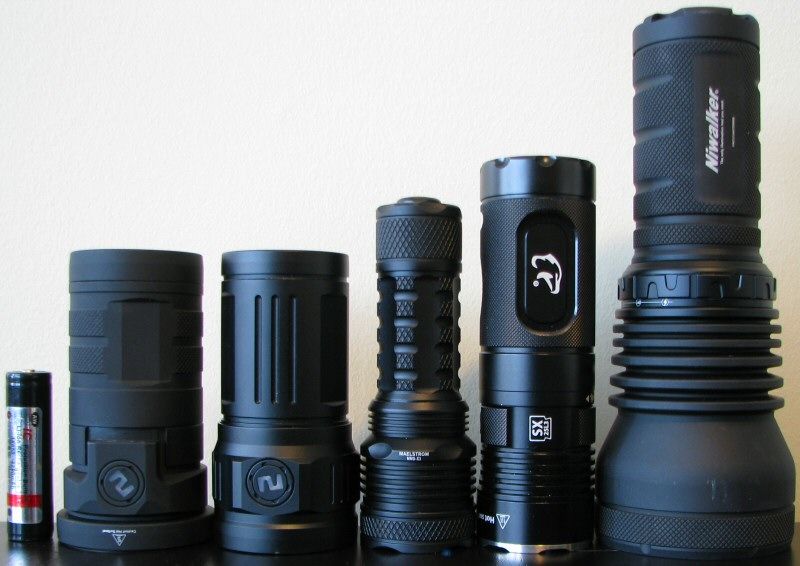
From left to right: AW Protected 18650 2200mAh; Niwalker MiniMax Nova MM15 shipping, prototype #1; Foursevens MMU-X3; Eagletac SX25L3; Niwalker BK-FA01.
Revised from the last prototype is an improved removable handle, which now has enough space to allow you to hold the light.
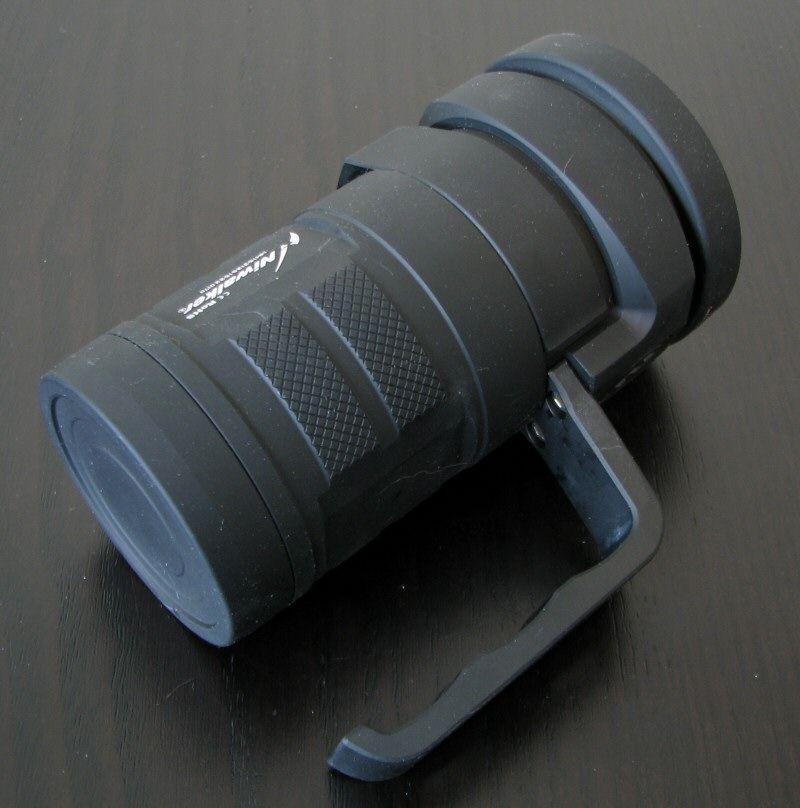
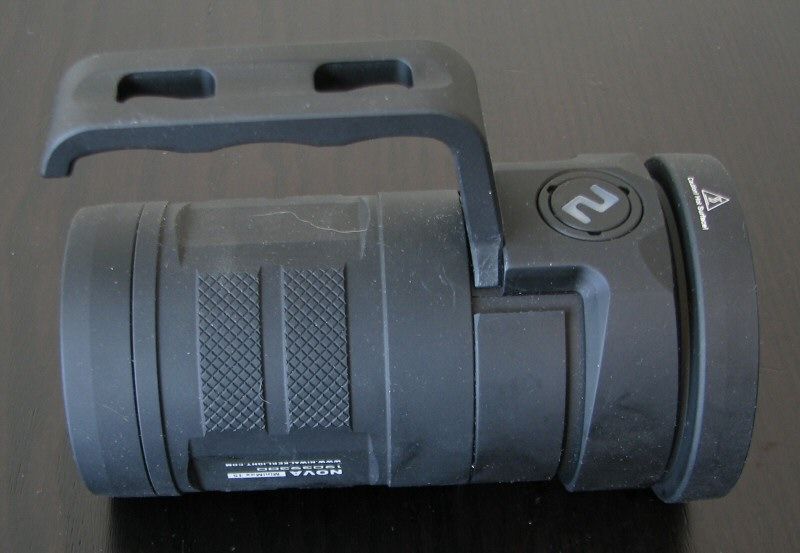
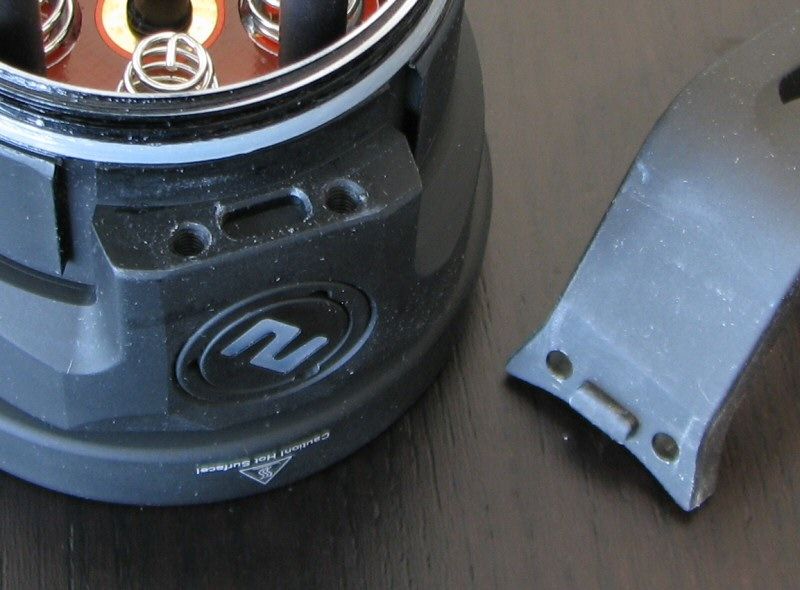
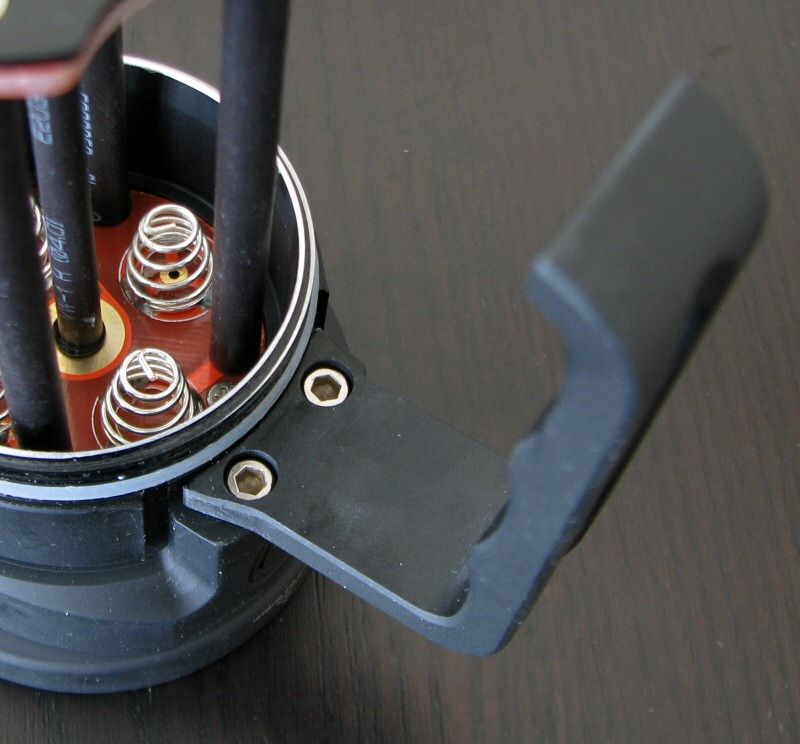
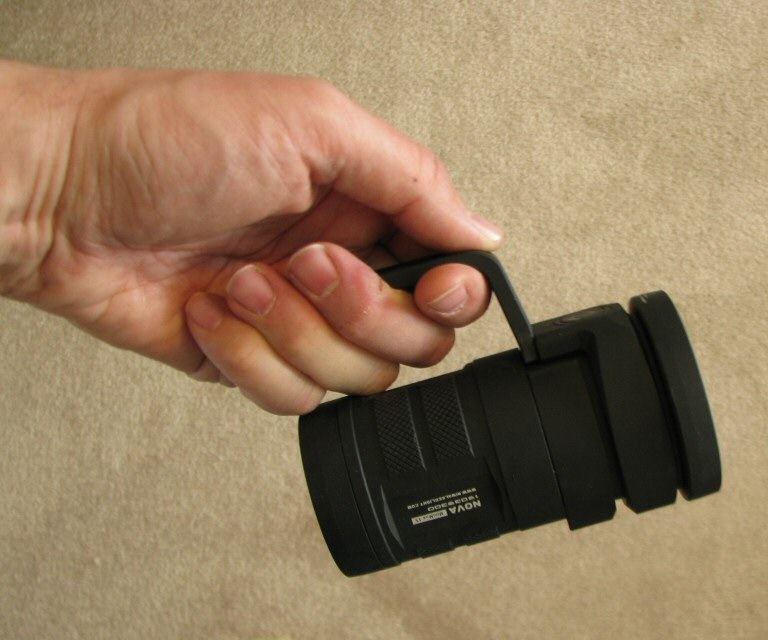
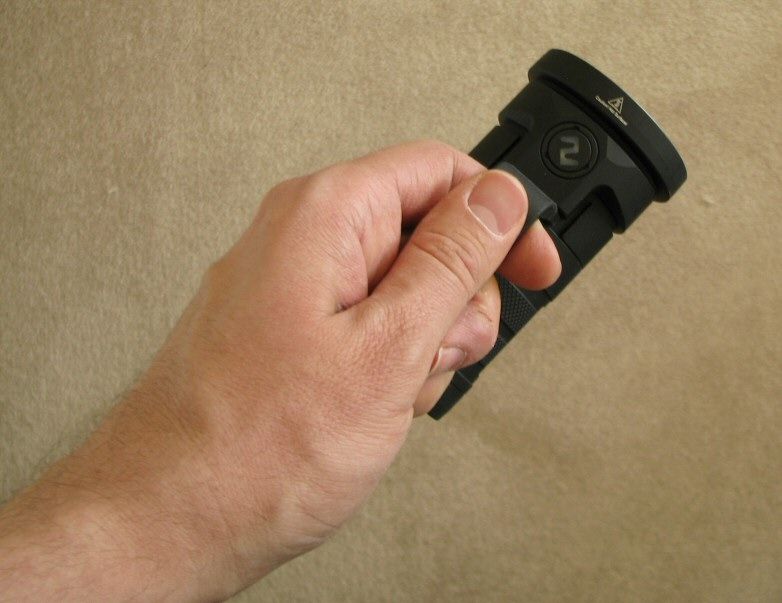
Personally, I don't really think the handle is necessary – the light is small enough to fit into your hand comfortably, and you are better off gauging the heat level by touch anyway.
All dimensions directly measured, and given with no batteries installed (unless indicated), and without the handle:
MiniMax Nova MM15 Shipping: Weight: 333.7g (without handle), 355.9g (with handle), (539g with 4x18650 and handle), Length: 114.6mm, Weight (bezel): 63.7mm
MiniMax Nova MM15 Prototype #2: Weight (with handle): 332.7g (516g with 4x18650), Length: 115.3mm, Weight (bezel): 60.7mm
MiniMax Nova MM15 Prototype #1: Weight: 268.3g (452g with 4x18650), Length: 114.0mm, Weight (bezel): 58.0mm
Eagletac SX25L3 3x18650: Weight: 315.9g, Length: 150.2mm, Weight (bezel): 47.0mm
[Crelant 7G10: Weight 643.4g (827g with 4x18650), Length: 198mm, Width (bezel): 79.0mm
Fenix TK75: Weight: 516.0g (700g with 4x18650), Length: 184mm, Width (bezel): 87.5mm
Nitecore TM11: Weight: 342.6g (476g with 8xCR123A), Length 135.3mm, Width (bezel): 59.5mm
Niwalker BK-FA01: Weight: 687.6g (870g with 4x18650), Length: 209mm, Width (bezel): 80.0mm, Width (tailcap): 50.3mm
Thrunite TN35 (MT-G2): Weight: 571.4g (723g with 3x18650), Length: 201mm, Width (bezel): 78.9mm
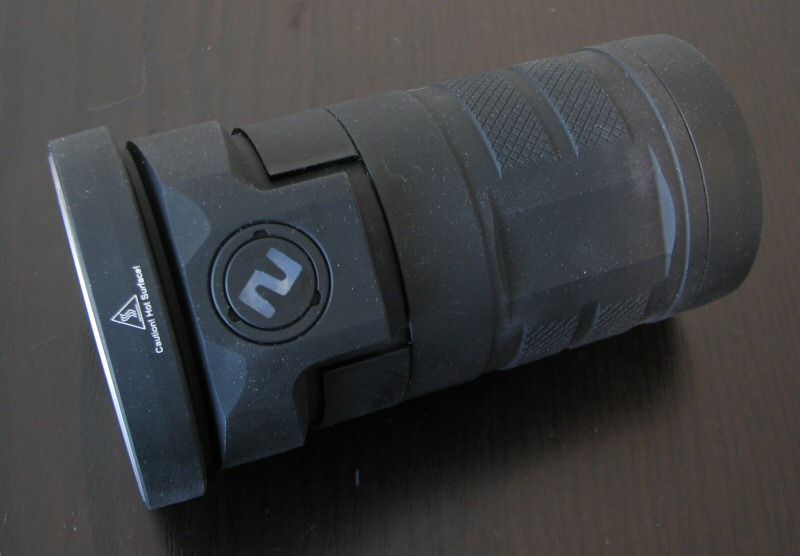
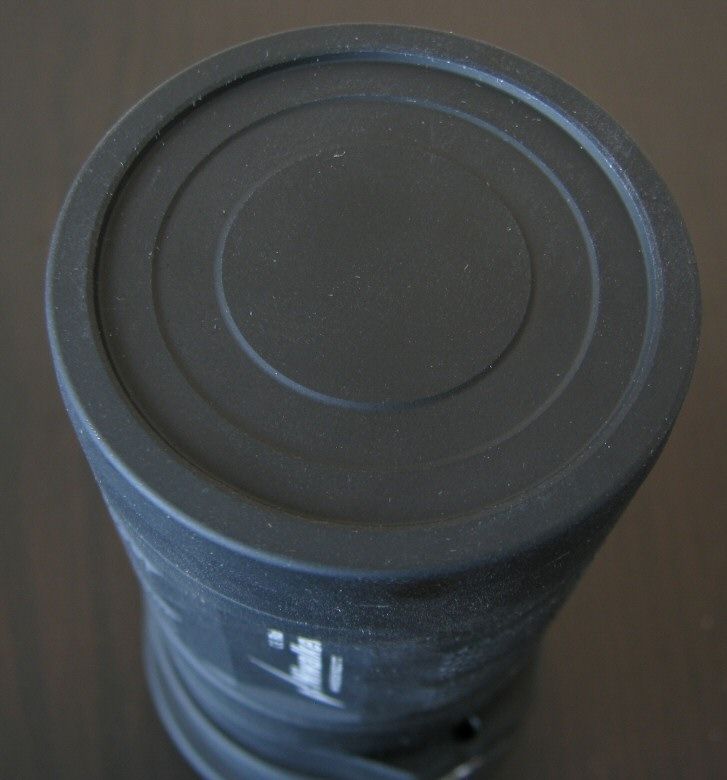
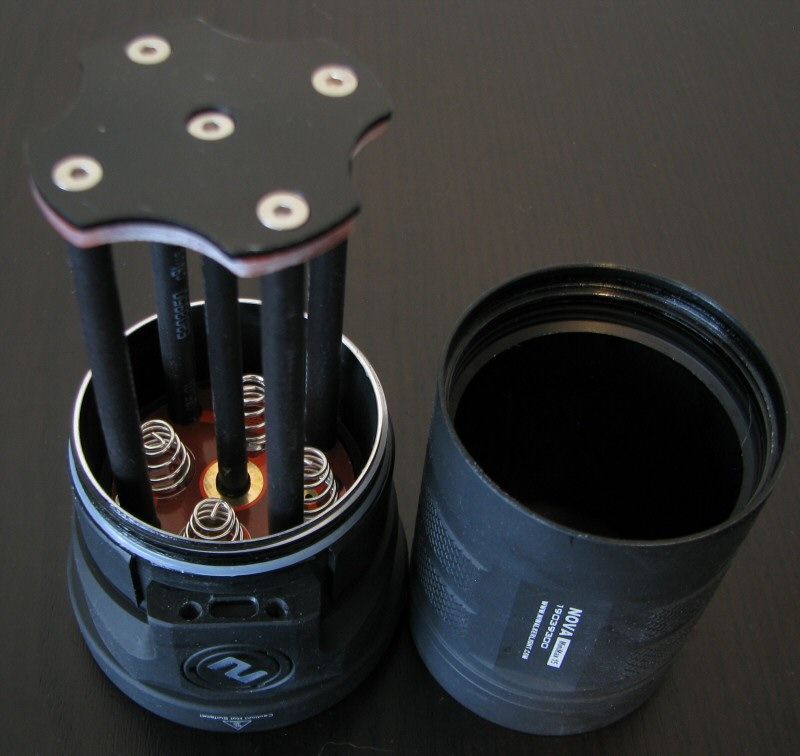
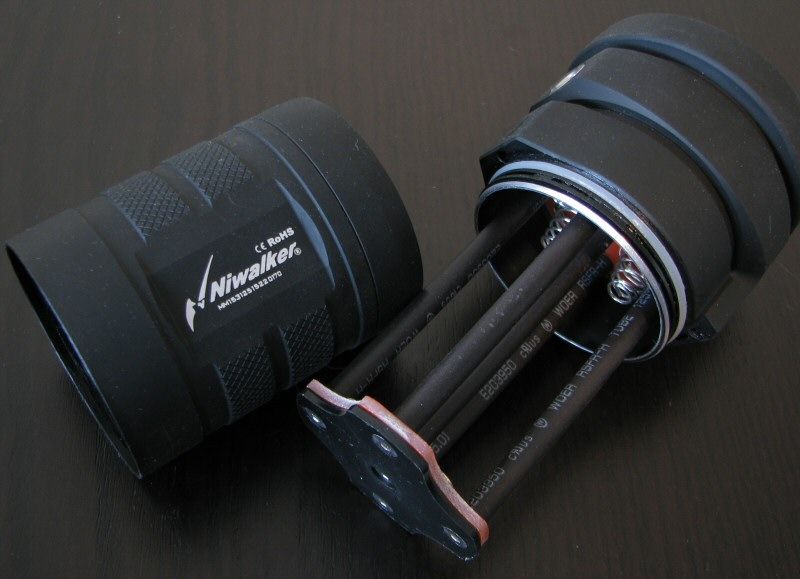
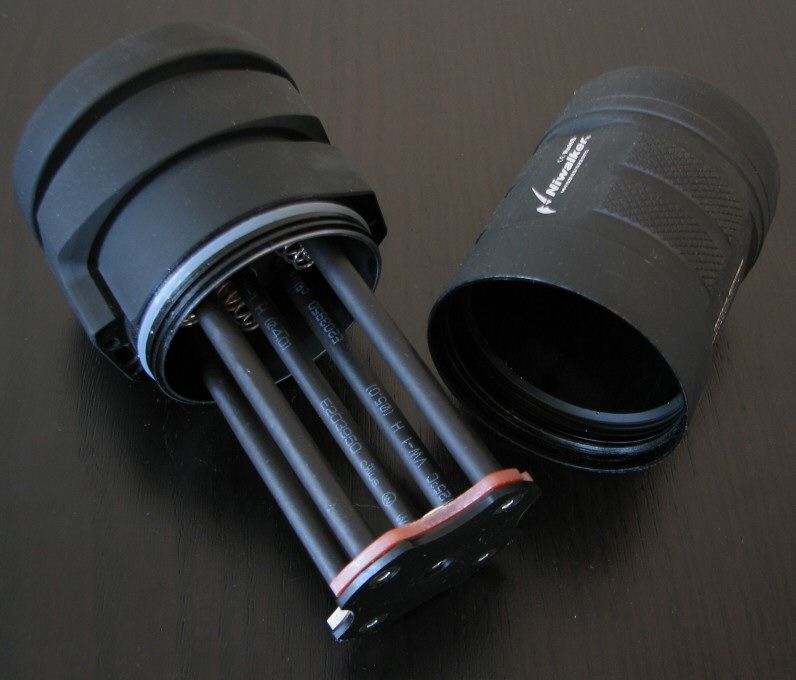
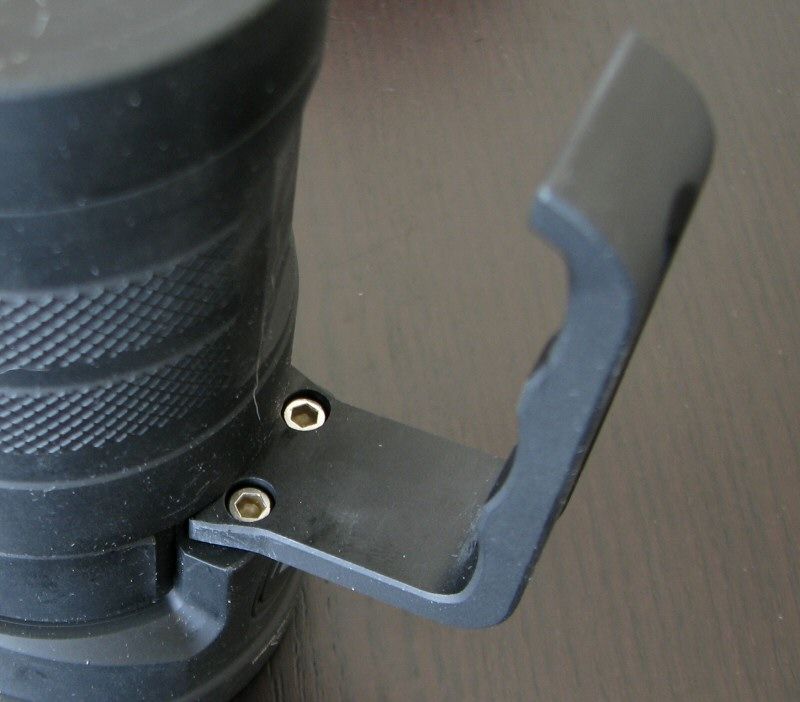
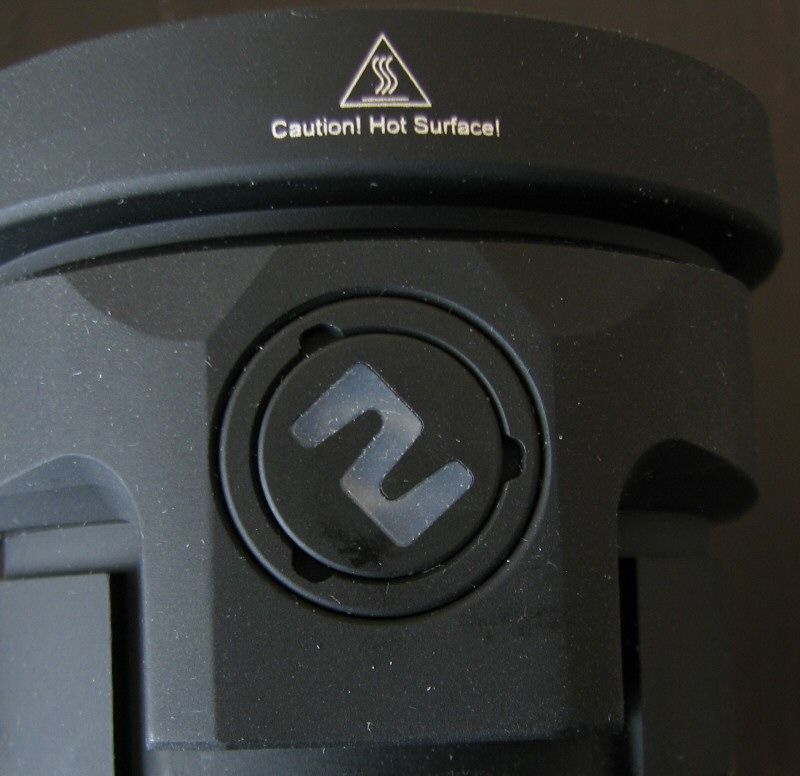
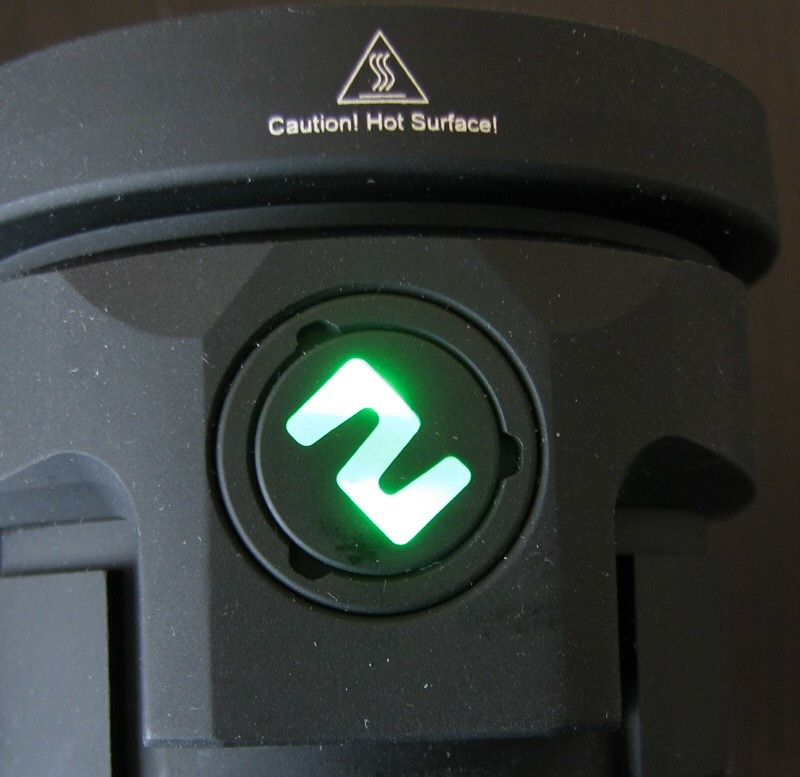
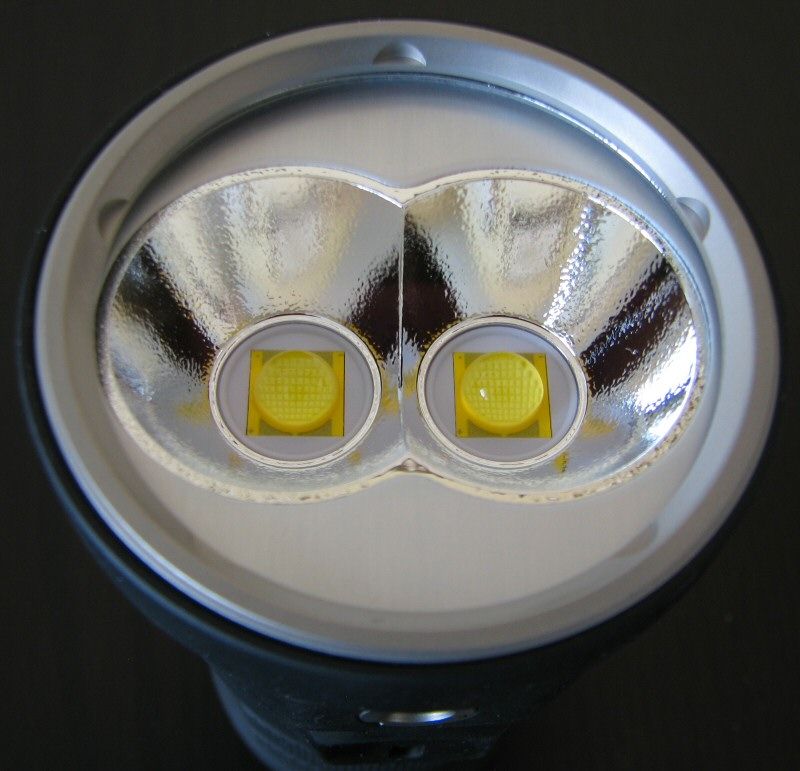
Build has been updated from the previous engineering sample, although overall size and dimensions are not very different from the second prototype. The most obvious change is in the anodizing – it is much thicker now, with a more "grippy" matte finish. It reminds me a lot of the Armytek anodizing. Note that this sort of finish with mark easily, but is much better to enhance grip.
Design of the body cover has changed as well, with some areas of actual knurling now (though it is not very aggressive). There are a number of model labels on the body tube now, bright white against the background. As before, this body tube is only a protective cover – there is an integrated battery carrier built into the head. Threading has changed slightly from earlier prototype; there are fewer threads now.
No lock-out is possible, due to the integrated carrier. The integrated battery carrier has been updated from the last version, with an improved design allowing easier access to the cells. Height of the built-in carrier is good, and most cells should fit (although really long or wide high-capacity cells may be a challenge to get in or out). As before, the four 18650 cells are in series, not parallel (i.e., 4s1p). See my analysis below for user interface changes.
Another major change is in the design of the removable handle. The handle has been raised appropriately, and the screw attachment points shrunken in size and recessed into the head. This is a better setup whether you plan to use the handle or not (i.e., less conspicuous screws now, and proper finger clearance). But it does make it hard to attach or remove.
As with the last engineering sample, there is also a lanyard attachment point and a reinforced tripod attachment point in the head. The switch is appropriately located directly in front of the handle, with an all-black button cover surround (and a "N" logo with green/red LEDs underneath). Note that the surround was stainless steel on the previous engineering sample - the final shipping version seems to have reverted to the original prototype model I reviewed. :shrug: Switch traverse/feel is pretty much unchanged across the versions, and about typical for an electronic switch. For those concerned about the brightness of the indicator button, see my post #2.
Let's take a look at the business end of the light, starting with the the MM15 Prototype #1:
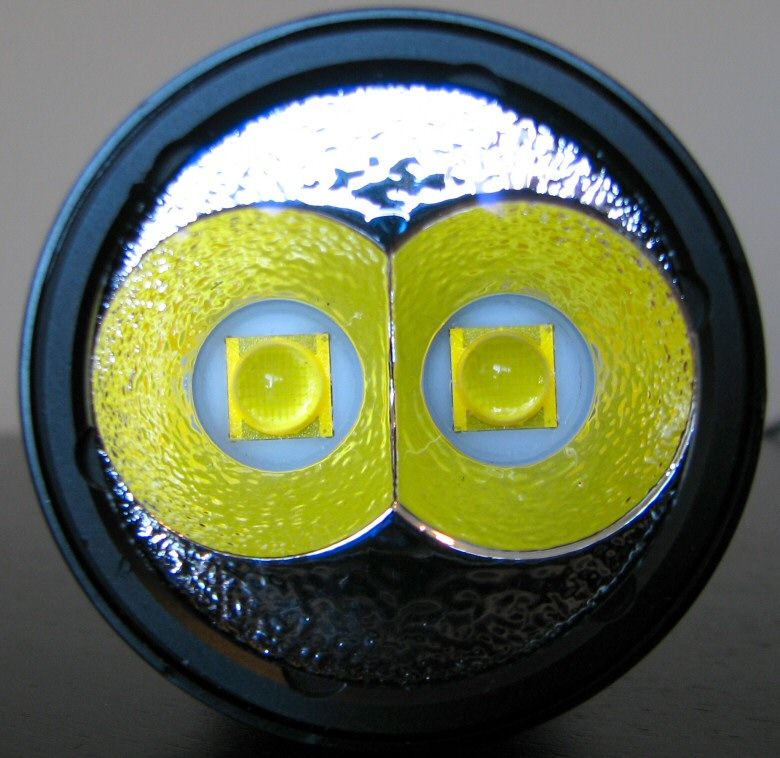
And then the MM15 Prototype #2:
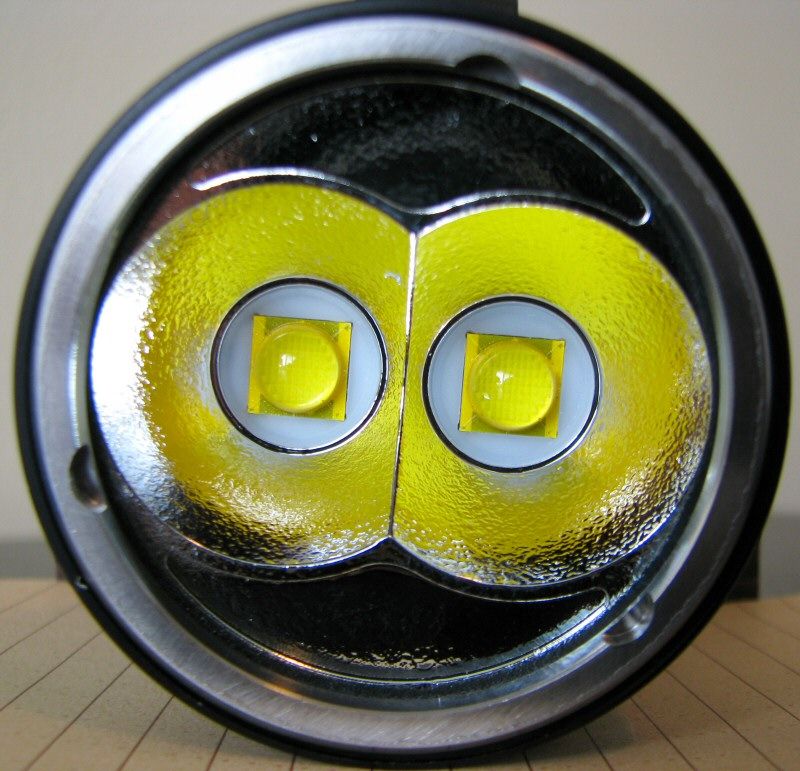
And now the final shipping version of the MM15:
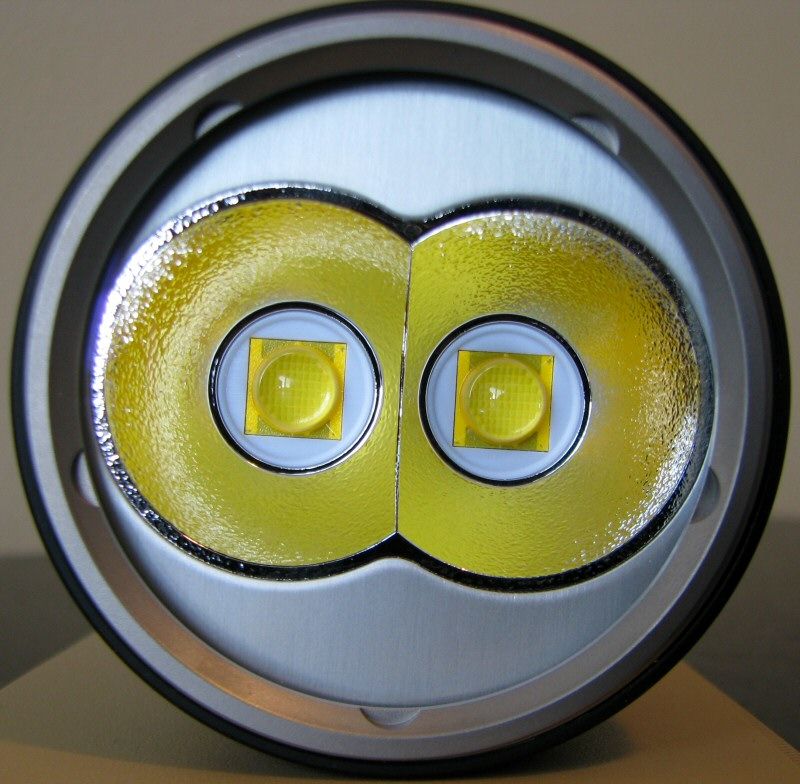
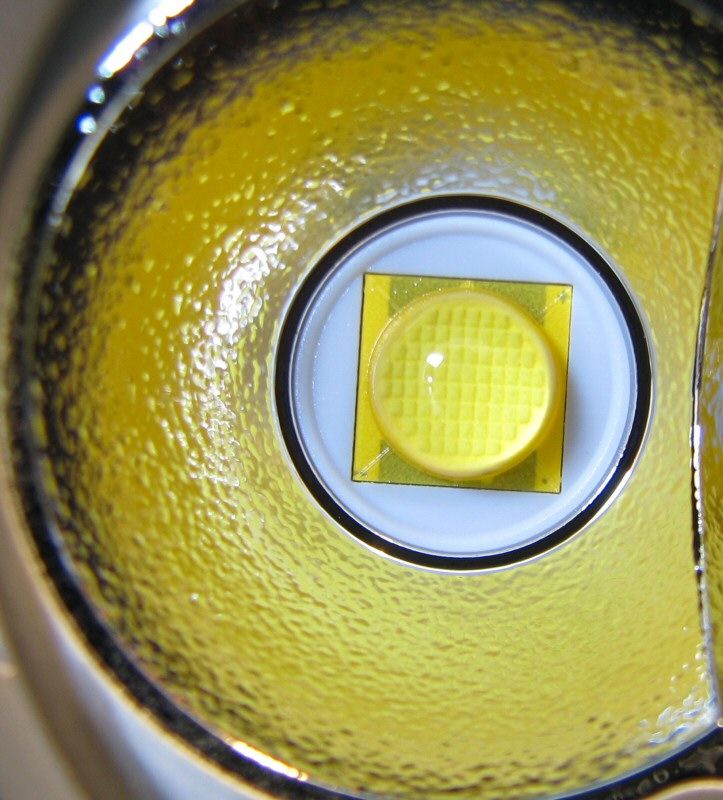
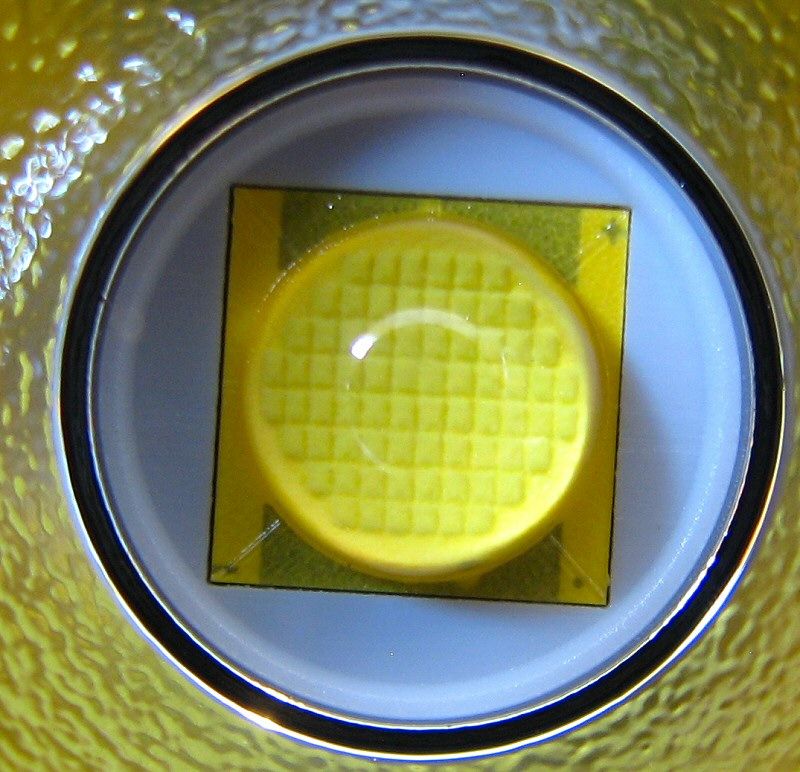
As before, the MiniMax runs off two MT-G2 emitters in relatively shallow reflector wells. The reflector wells are a "light orange peel (LOP)" finish, compared to the heavily textured first prototype. It is still very much a flood light (scroll down for beam shots).
With the stainless steel bezel ring, the head and reflector have a quality appearance on the final shipping version. :thumbsup:
Note that as always, the MT-G2 emitter only comes in a variety of relatively neutral-warm tint bins (i.e., the coolest one available is 5000K). All the MT-G2 samples I've seen have certainly been in the typical "Neutral White" ~4000-5000K range, and this model is no exception.
Scroll down for beamshot comparisons.
User Interface
The user interface has been updated slightly from the last prototype.
As before, turn the light on/off by the electronic switch. There is now a momentary mode – press and hold the switch for momentary Turbo output. Alternatively click the switch (i.e., press and release) and the light comes on in constant output.
As before, once On, press and hold the switch to cycle through all the regular modes in sequence: 1 > 2 > 3 > 4 > 5. I would consider these as Ultra-lo > Lo > Med > Hi > Higher. Release the switch to select the desired level. You can restart the level ramp at any time, but the ramp always starts at Level 1 (i.e., ultra-lo). Note that as before, Turbo is not on the regular mode sequence (i.e., think of it as level 6).
The shipping MM15 has mode memory for the regular non-Turbo modes, and returns to last setting used from off.
Double-click from On to access Turbo. Double-click repeatedly for the strobe modes, in the following repeating sequence: Turbo > Strobe > SOS > Beacon. Note there is no mode memory for Turbo or the strobe modes.
You can access Strobe directly from Off now, by double-clicking switch. This means that you can have the light come on in Turbo or Strobe at any time.
There is an electronic lock-out mode, accessed by a rapid triple-click of the switch from Off. The two MT-G2 emitters will flash twice to indicate the lock-out is engaged. Another triple-click re-activates.
There is a standby indicator that flashes when the batteries are connected but the light is not on (i.e., a brief green flash of the "N" switch occurs exactly every four seconds on my sample). As before, the switch lights up in constant green when in use. The N changes to red as the cells near exhaustion – this is a warning to switch down to a lower level, as the light will shut-off automatically soon (due to an internal shut-down feature in the circuit). I provide details on this in my testing below. You can re-activate after the light shuts down, by pulling one of the cells out and re-installing.
For those concerned about the brightness of the indicator button, see my post #2.
Video:
For more information on the overall build and user interface, please see my video overview:
As with all my videos, I recommend you have annotations turned on. I commonly update the commentary with additional information or clarifications before publicly releasing the video.
PWM/Strobe
Reviewer's note: I have recently updated my oscilloscope software, so the traces below may look a little different from my earlier reviews.
As before, there is no sign of PWM that I can see, at any output level – I believe the MiniMax is current-controlled.
Noise:
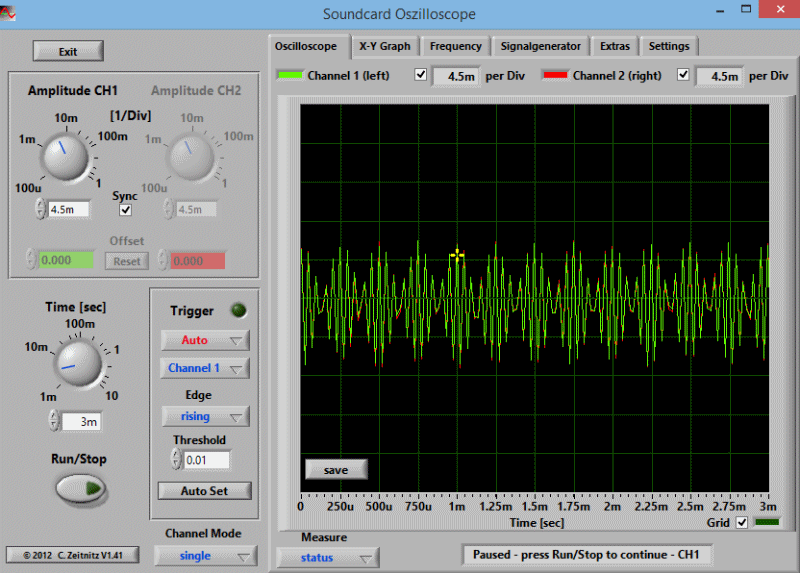
As before, there is some noise is the high kHz range on the L2 through L5 levels (i.e., not on Moonlight or Turbo). It is quite common to see high frequency noise in current-controlled lights. Consistent with my standard review policy, I report on anything I can detect on a light. Rest assured, these signals are not visible to the eye in actual use – the light is fully flicker-free in all modes.
Strobe:
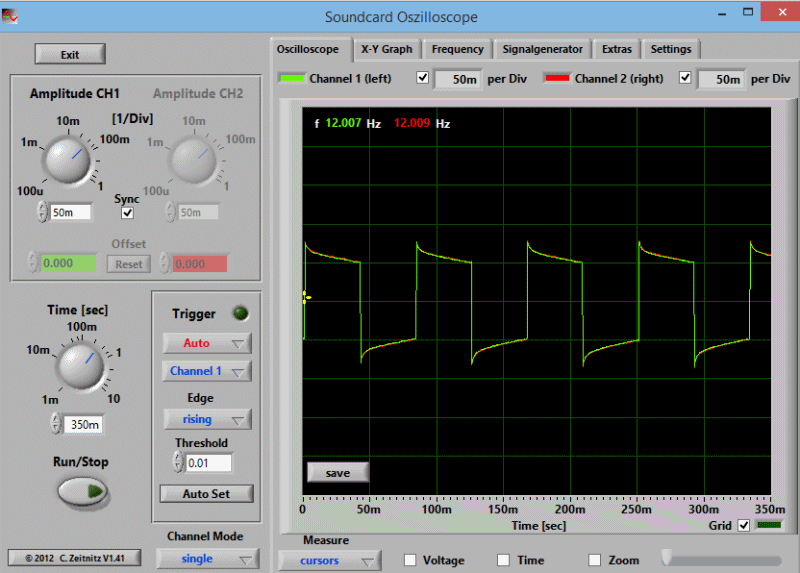
The strobe mode was a fairly typical 12Hz fast strobe (up from 10 Hz on the prototypes).
SOS:
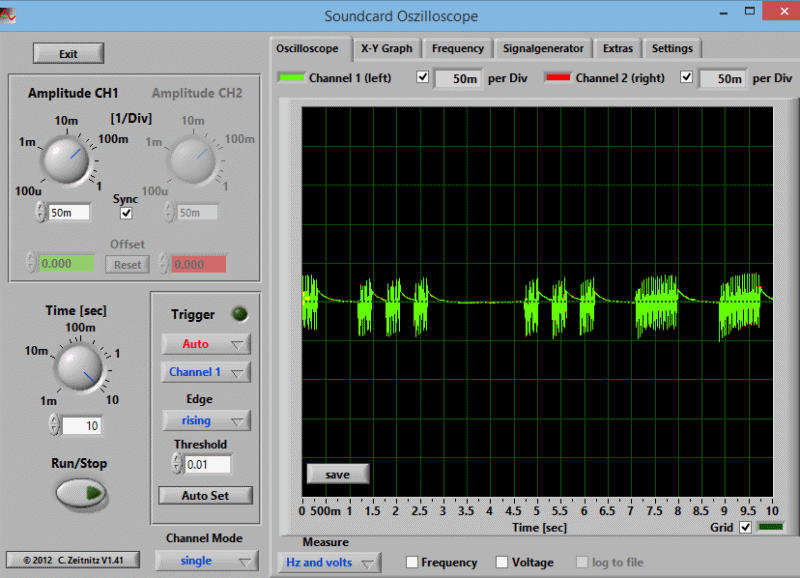
A fairly typical SOS mode is included.
Beacon:
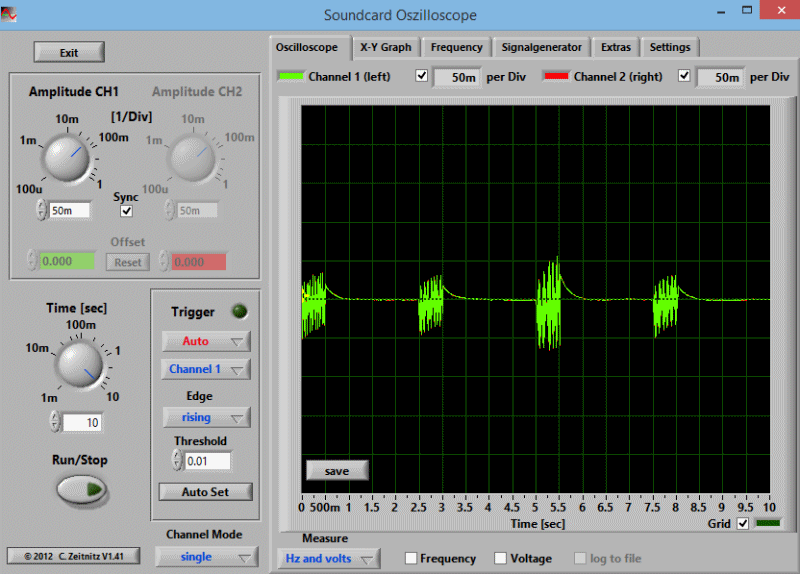
The new beacon mode on the shipping version is a half-second pulse of light, repeated every 2.5 secs (i.e., 4 pulses in 10 secs, as shown above).
Standby Drain
A standby current drain is inevitable on this light, due to the electronic switch. Despite how the carrier looks, the batteries are actually all in series, as before (i.e. 4s1p arrangement).
On the shipping sample I measured this as 460uA initially, but it rapidly drops down over 30 secs or so to settle at 370uA. This is reasonably low.
However, the standby indicator flash every three seconds causes a jump in current to 4.8mA when it is lit (on the shipping sample). If we use ~1.5mA as a rough overall average current (i.e., averaging the current over 4 secs), that would give you 2 and a half months before 3100mAh cells would be exhausted.
As before, there is no physical lock-out available (i.e., you would need to pull one of the cells). But Niwalker has added an electronic lock-out mode (triple-click the switch from off).
I have measured the current in lock-out mode, and it is no lower than the stable standby drain (i.e., 370uA). However, the standby indicator no longer flashes, and the light cannot be activated accidentally. So, in this lock-out mode, except almost a full year before 3100mAh cells would be fully drained.
FYI, in terms of the "N" logo indicator switch, I previously observed that the indicator LED goes red once the cells drop below ~3.45V when run the L5 level, ~3.40V on the L4 level, ~3.35V on the L3 level, ~3.30V on the L2 level. This gives you a reasonable amount of advance notice that it is time to change the batteries. :wave:
Beamshots:
And now, what you have all been waiting for. All lights are on their standard battery, or AW protected 18650 2200mAh for the multi-18650 lights. Lights are about ~0.75 meter from a white wall (with the camera ~1.25 meters back from the wall).
All lights are on their standard battery, or AW protected 18650 2200mAh for the multi-18650 lights. Lights are about ~0.75 meter from a white wall (with the camera ~1.25 meters back from the wall).
Automatic white balance is used on most of my wall beamshots (to minimize tint differences), but in this case I went with a Daylight WB on my Canon for the MiniMax prototypes.
Note the second generation prototype is labelled "MiniMax #2 Proto", and the final shipping sample is labelled as "MM15 ship 2xMT-G2".

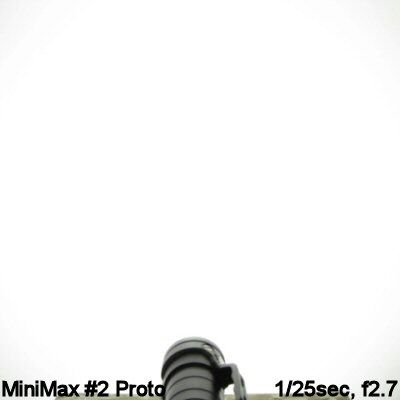
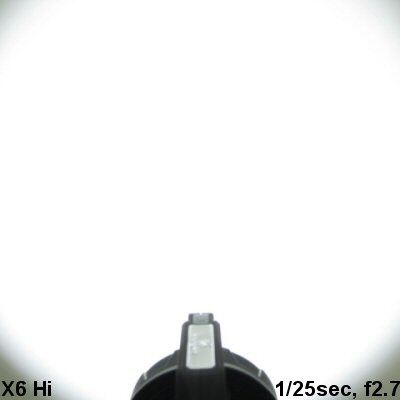
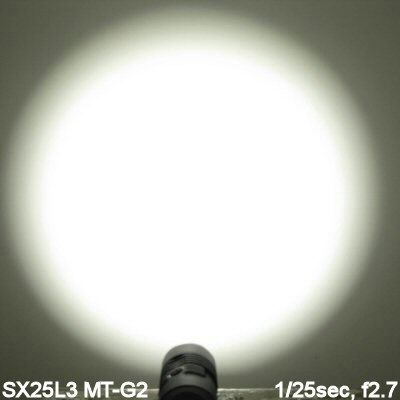
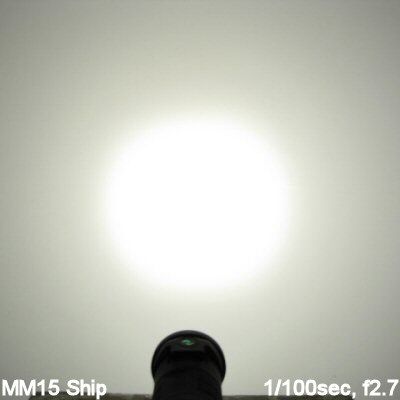
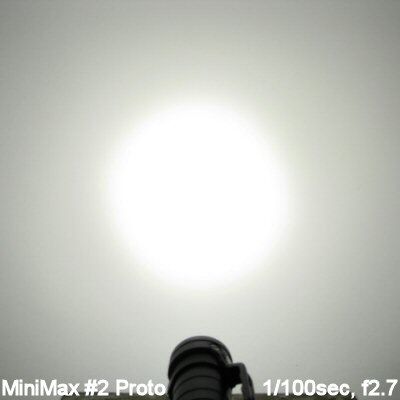
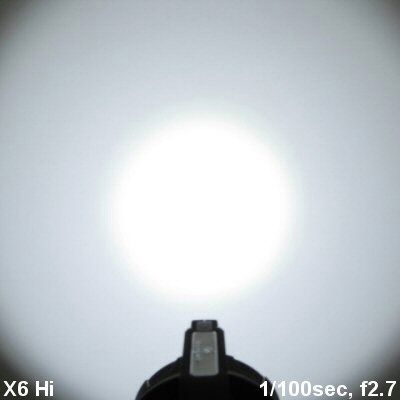
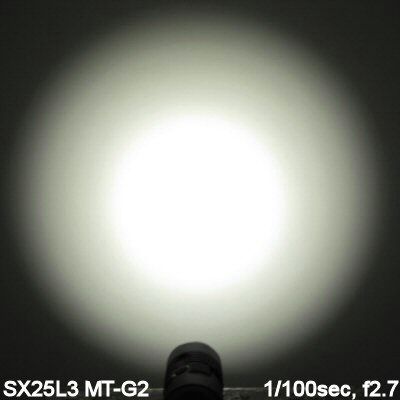
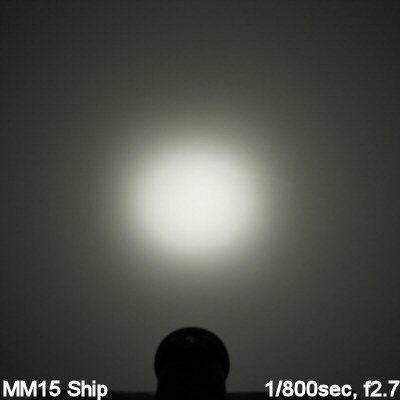
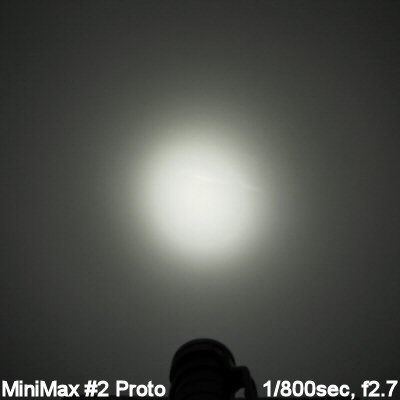
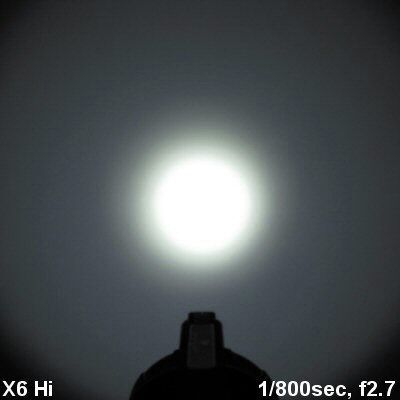
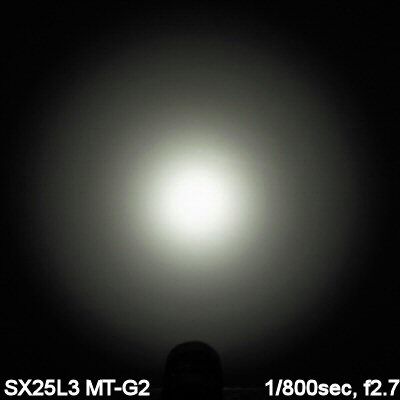
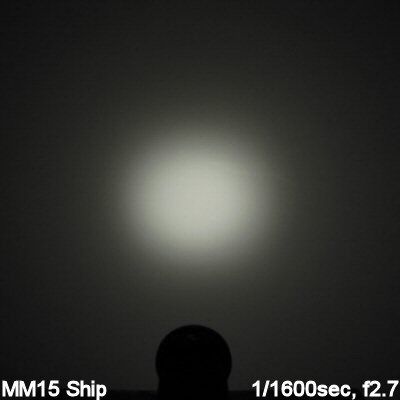
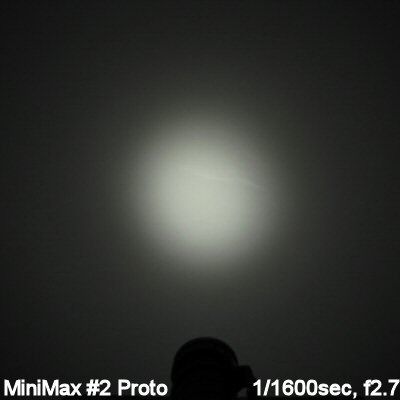
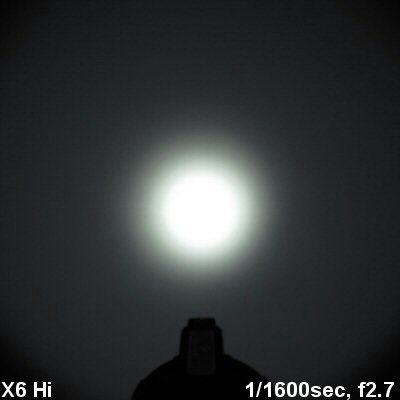
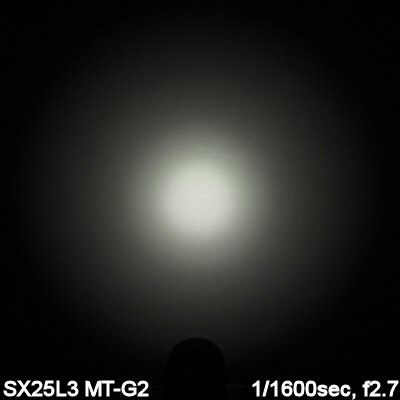
Note: No matter what white balance I use, these comparisons will never be entirely accurate for tint. In real life, I find my MT-G2 lights all to be relatively neutral white, without a huge difference between them.
As before, the MM15 has an unbelievable amount of output on Turbo. Hard to directly compare, but my ceiling bounce results tell me that my final shipping sample is intermediate in output to my two previous prototypes.
Since the beam profile really hasn't changed from the second prototype, I've stuck with the indoor comparisons from that review. For your reference, the back of the couch is about 7 feet away (~2.3m) from the opening of the light, and the far wall is about 18 feet away (~5.9m). Below I am showing a couple of exposures, to allow you to better compare hotspot and spill. And again, the camera is set to a Daylight white balance for all lights below.
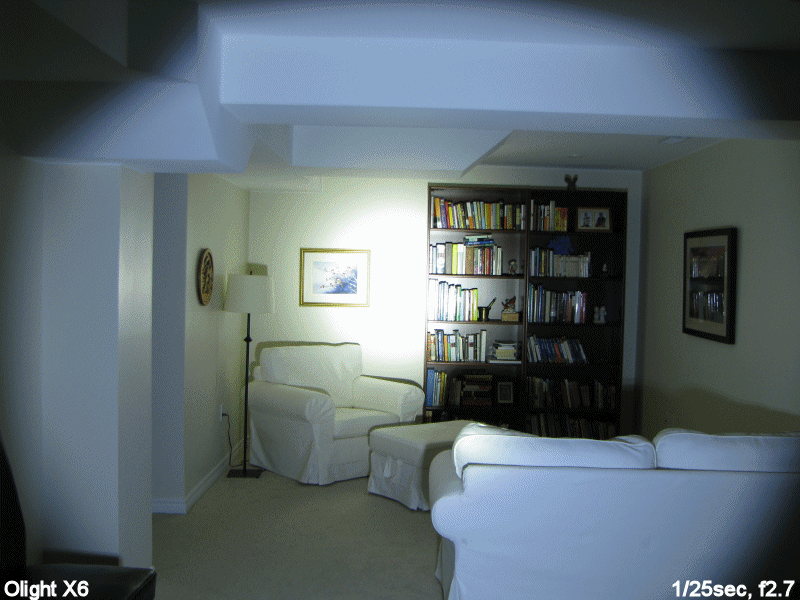
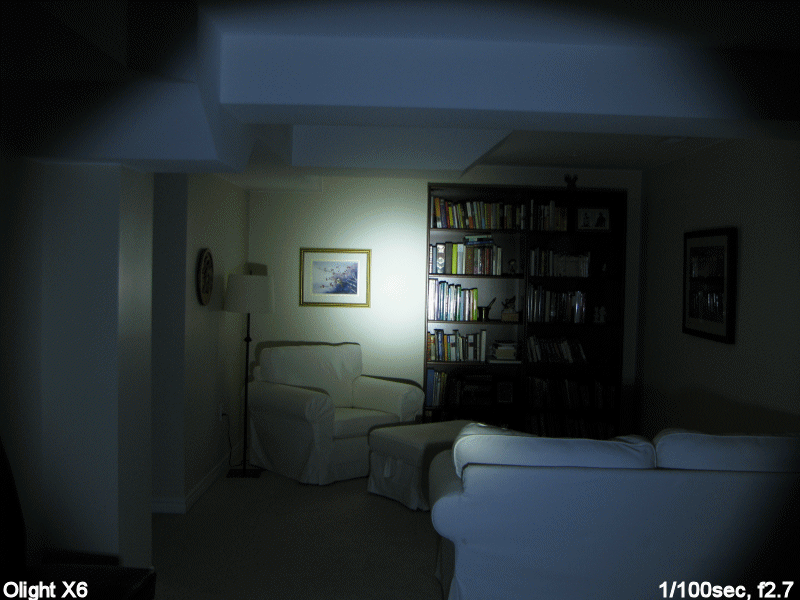
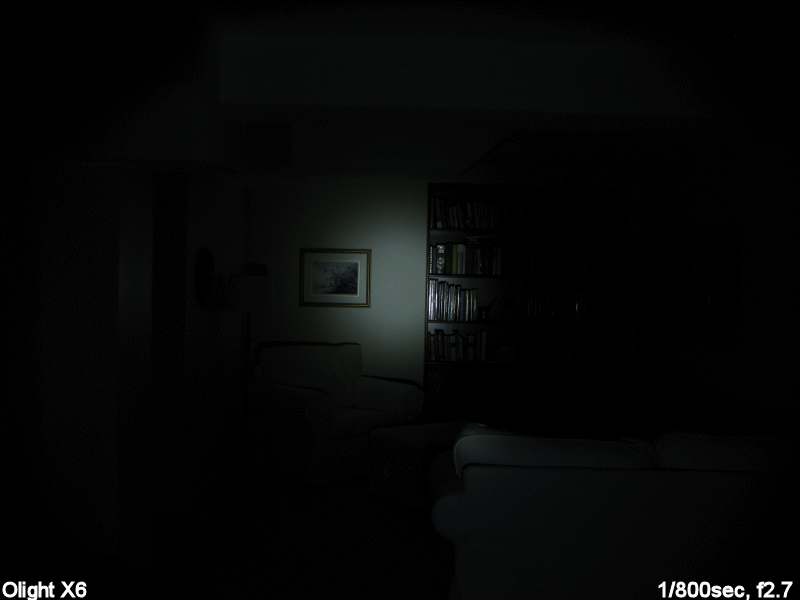
Again, these are all done with a Daylight white balance, to better show tint differences. But a single white balance will never capture the true difference between lights – in practice, the X6 is not that cool, and the MM15s are not that warm. :shrug:
Despite how it may seem, the MM15 is really a pure flood light. Scroll down for actual output and throw measures.
For outdoor shots, I'm waiting on a couple of modified MM15vn samples from Vinh Nguyen – I will be heading to take new pics as soon as they arrive. In the interim, here are the outdoor beamshots from my prototype reviews (the beam pattern is basically unchanged). As always, these are done in the style of my earlier 100-yard round-up review. Please see that thread for a discussion of the topography.
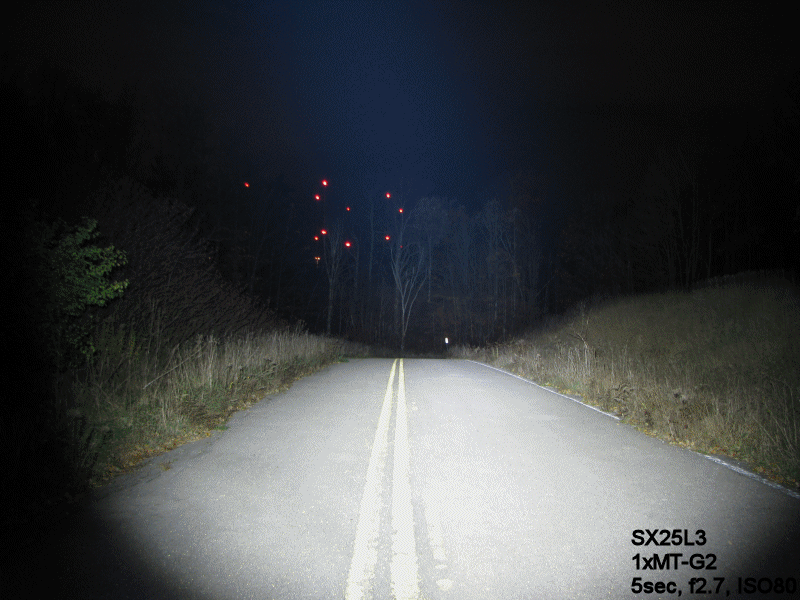
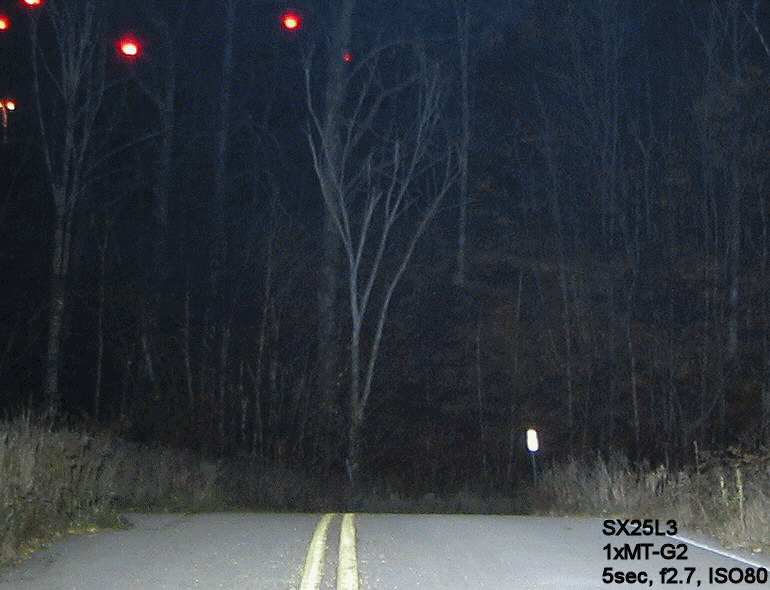
Given that this location was picked to illustrate relative throw (which the MM15 is not designed for), it doesn't really capture the overall brightness of this light very well – recommend you stick with the indoor basement shots for now.
That said, you can get a few hints of its relative brightness if you examine the far right end of the zoomed-out shots above (i.e., the tree line in the distance on the right). Depending on your monitor calibration, you may be able to faintly make the trees there (which are more than 100 yards away). You'll note how much hard it is to see these on the comparator SX25L3 or X6.
Again, I plan to update these beamshots soon with the final shipping version and the modified light from Vinh Nguyen – check back for updates. But for now, the stock MM15 looks very much the same as what is shown above.
EDIT: For outdoor beamshots comparing the stock MM15 to the dome-on and dedome versions of the modded MM15vn, please check out that new review.
Testing Method:
All my output numbers are relative for my home-made light box setup, as described on my flashlightreviews.ca website. You can directly compare all my relative output values from different reviews - i.e. an output value of "10" in one graph is the same as "10" in another. All runtimes are done under a cooling fan, except for any extended run Lo/Min modes (i.e. >12 hours) which are done without cooling.
I have devised a method for converting my lightbox relative output values (ROV) to estimated Lumens. See my How to convert Selfbuilt's Lightbox values to Lumens thread for more info.
Throw/Output Summary Chart:
My summary tables are reported in a manner consistent with the ANSI FL-1 standard for flashlight testing. Please see http://www.flashlightreviews.ca/FL1.htm for a discussion, and a description of all the terms used in these tables. Effective July 2012, I have updated all my Peak Intensity/Beam Distance measures with a NIST-certified Extech EA31 lightmeter (orange highlights).
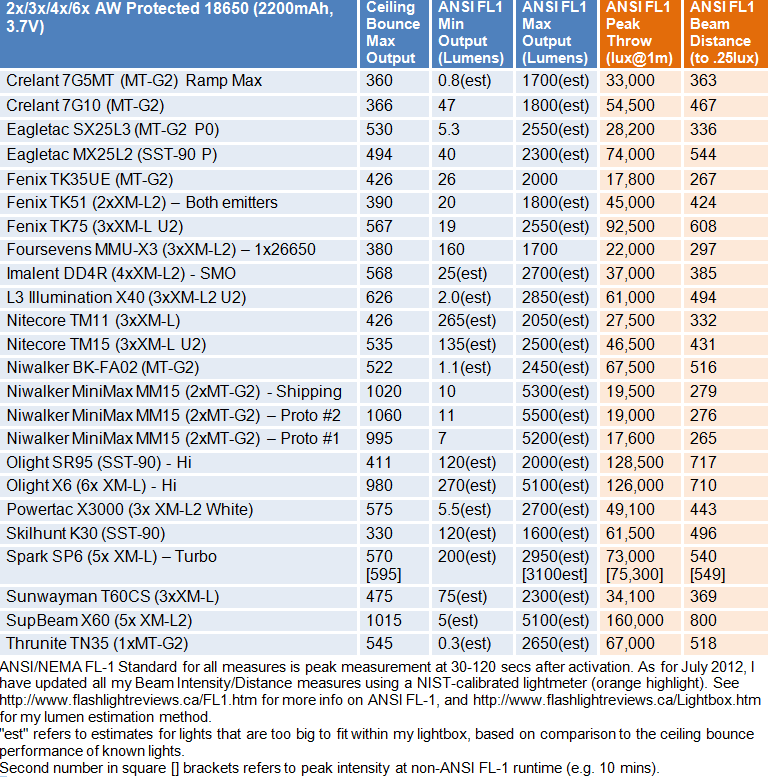
Since my high-output lights don't fit in my lightbox, I am really relying on my ceiling bounce measures here. The second MM15 prototype was an outstanding performer, and my shipping sample is intermediate to the first and second prototypes. At ~5200-5500 lumens across the three samples, this is a clearly an outstanding output performer for the size. :bow:
Throw remains definitely pretty minimal, given the overall output of the MM15. As always, the MT-G2 produces a very smooth beam profile.
Let's see how the rest of the output levels compare, between the various samples.
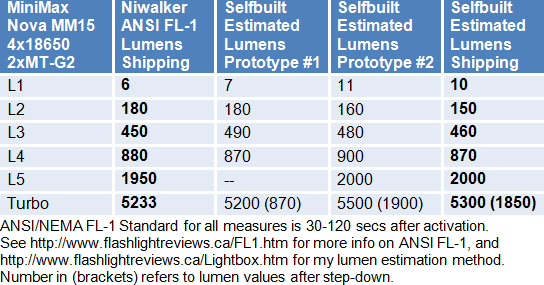
Note that with the second prototype, Niwalker added a fifth regular mode – which is also the step-down level from Turbo. There is a very close match to my results across the various samples, and to Niwalker's reported specs.
Ever since the second prototype, Niwalker has been using thermal step-down from Turbo (as opposed to the timed step-down on the first prototype). See runtimes for more info.
Output/Runtime Graphs:
UPDATE MAY 20, 2014: First off, a MAJOR apology to all who have been following the development of this model. I accidentally mislabeled some of the runtimes in my testing of the second prototype review. Normally, that would only have been a minor error on the figure legend. But because the MM15 doesn't completely fit inside my lightbox, I do a calibration adjustment to get the right output scale. This means that the wrong adjustment was applied to several of the prototype #2 runtimes, giving the wrong output level on the graphs.
I am truly sorry about this everyone. I am revised all the graphs below (and in the second prototype review). My thanks again to RedForest UK - it was his current drain data that helped me track down my error. :thumbsup:
As always, before I get started, my standard runtimes are done on AW protected 18650 2200mAh cells, under a cooling fan.
Let's start with the higher output modes of the new shipping MM15:
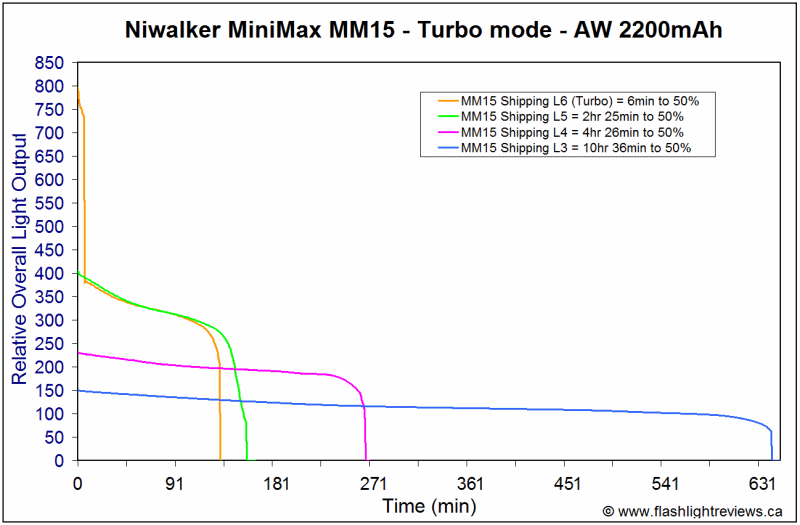
As before, the thermal sensor kicks the light down from Turbo to L5 after a few mins of continuous runtime. It took about 6 mins in the runtime above, which was done under fan cooling. Without cooling however, it would likely have stepped down within ~3 mins. As always, I don't recommend you rely on thermal sensors to control output – on super-high output lights like this, you should always be holding the light in your hand on the higher levels, to gauge relative heat and to allow you to turn down the light as necessary.
Let's see how the final shipping version compares to the previous prototypes:
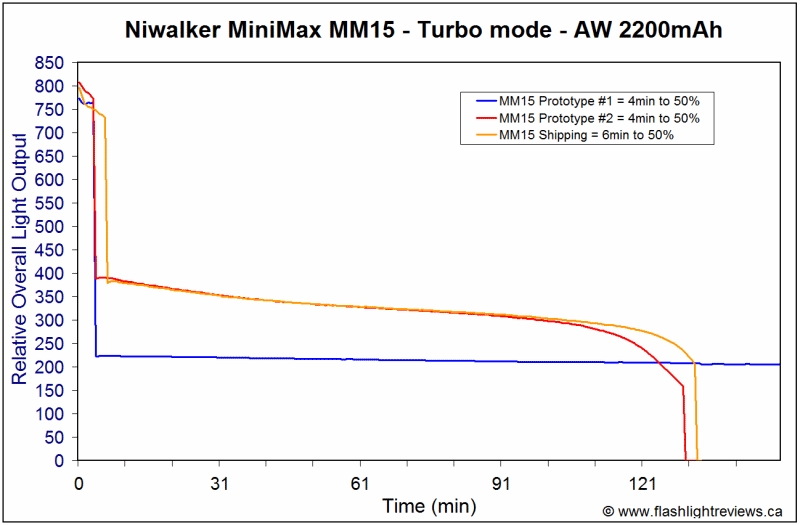
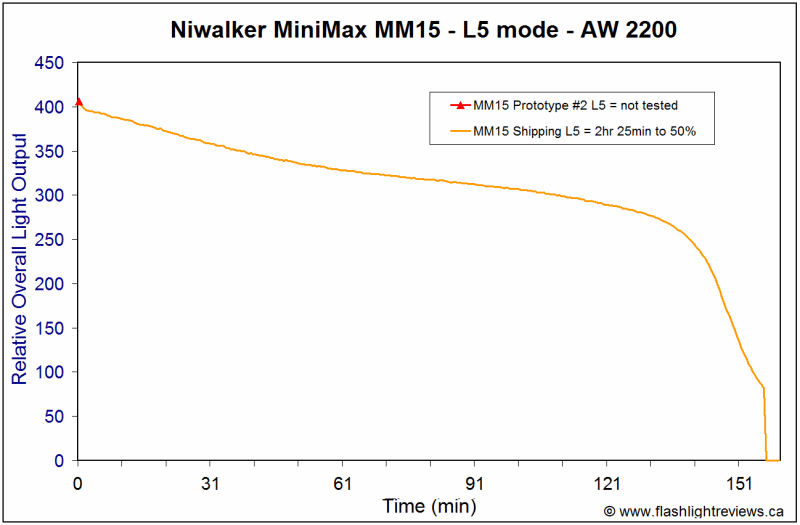
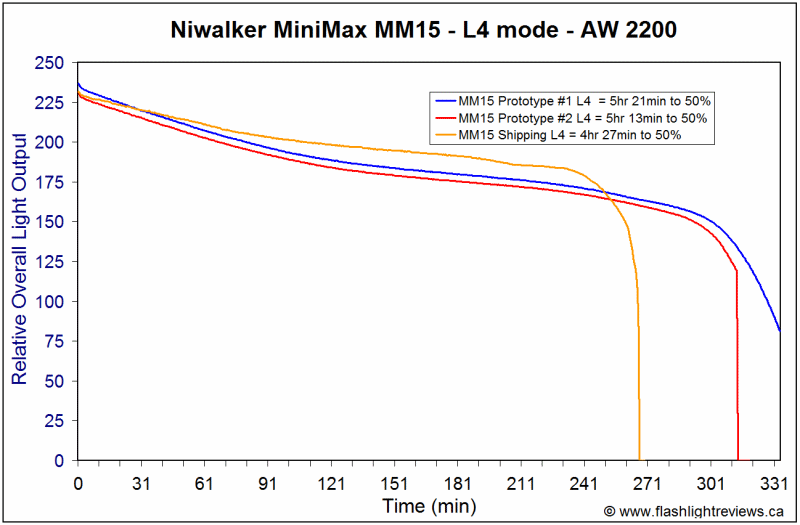
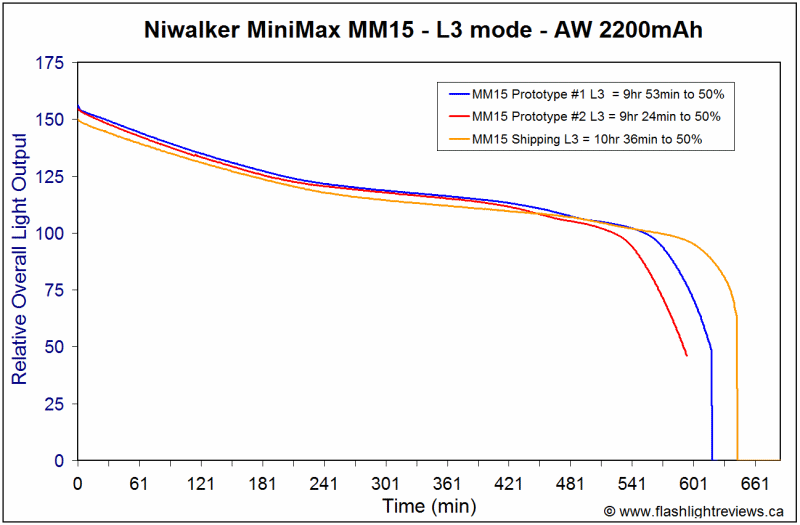
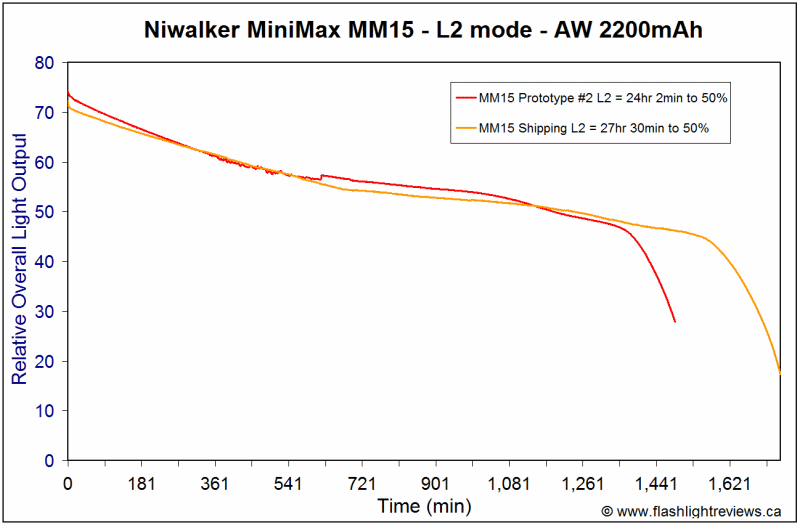
Now that I have fixed my glitch from the second prototype review, you can see that performance is basically unchanged from the earlier prototypes. This makes a lot more sense now, based on the output/current draw results. Unfortunately, I missed the L5 runtime on the second prototype sample, and no longer have this prototype to re-test (it was sent to Vinh Nguyen for mod testing, and didn't survive the experience).
In case you are wondering how higher capacity cells might fare, here is a comparison of the L4-L6 modes run on NCR18650A 3100mAh cells:
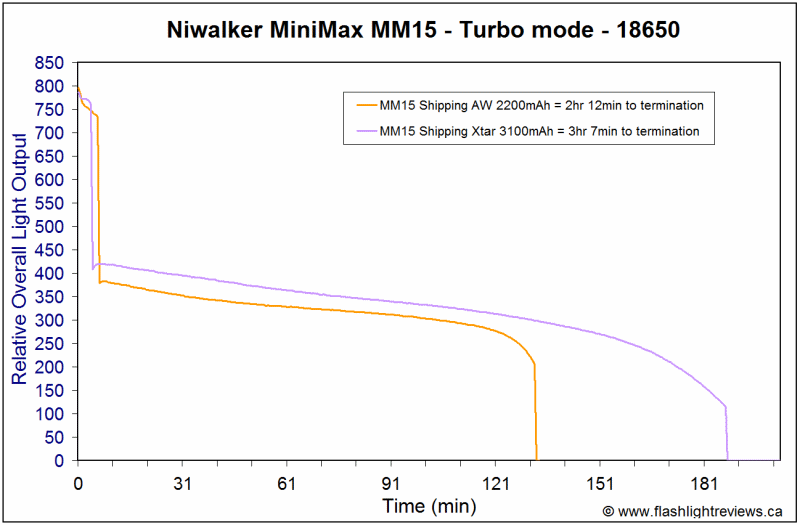
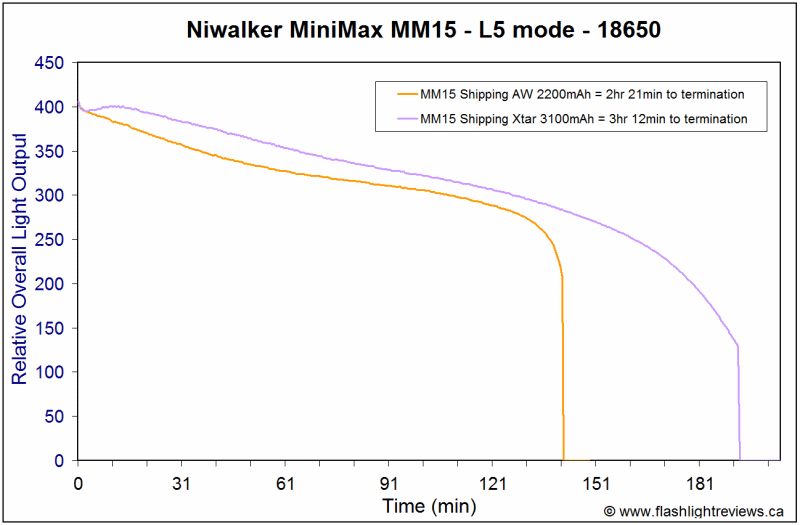
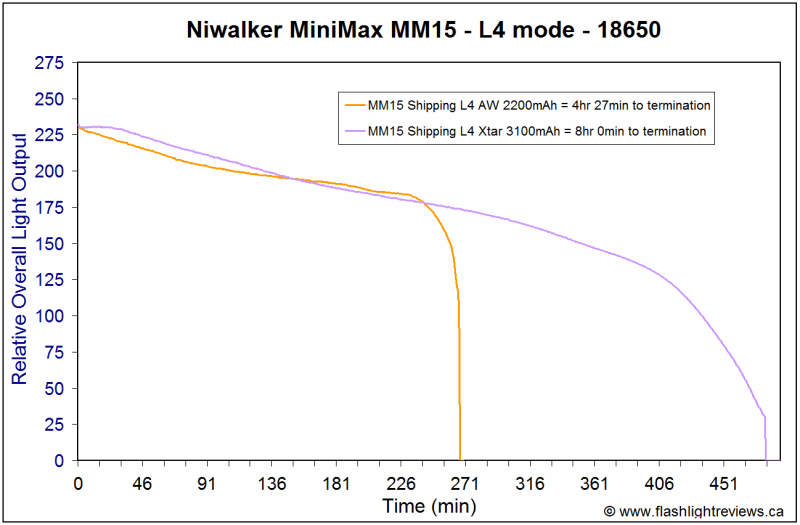
In addition to greater runtime, these cells were also able to keep the output mode slightly more stable at the higher L5 and Turbo settings (at least in the beginning). This means you get brighter light for longer on these levels. On L4, the real advantage was in extended runtime (for comparable output).
FYI, Niwalker reports that they got 4+ hours runtime on L5 with 3400mAh batteries before manually stopping the test (while the light was still fairly bright, all cells >3.19V).
I am waiting on a couple of modified MM15vn samples from Vinh, and will update this review once I see how they perform. :wave: EDIT:The review of the modded MM15vn samples is now up.
Let's see how the MM15 compares to other MT-G2 lights in my collection.
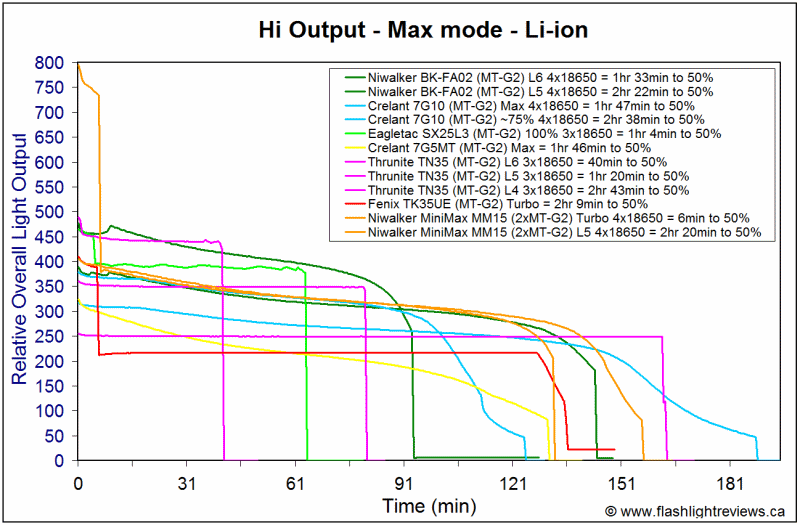
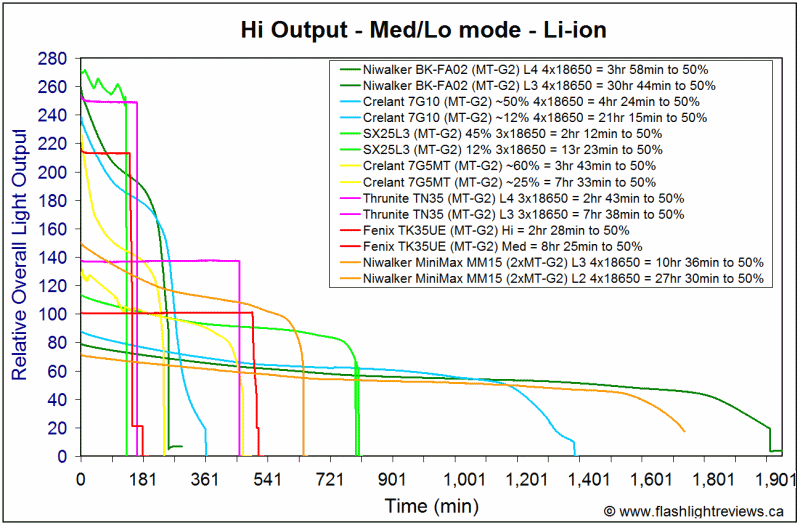
Again, these results make more sense now that I've corrected my output curves. Basically, overall efficiency of the MM15 is identical to the Niwalker BKFA02, at all comparable levels. Even though there are two emitters the MM15, it isn't providing any real efficiency advantage over the BKFA02. But due to the largely direct-drive like pattern, these two Niwalker lights remain the most efficient MT-G2 lights in m collection at the moment.
Of course, a lot of that has to do with the fact that the Niwalker lights are direct-drive on all modes. I have also queried this with Niwalker, and they respond that this is intentional: the MM15 in particular is not designed to have flat regulation, as this would likely result in overheating issues. They actually experimented with a constant-current circuit, but found the light got too hot on L5 and L6. In contrast, they report the light was always comfortable to use by hand outdoors when a direct-drive circuit was installed. Further, they point out that with this circuit in place, there is no visible step down required – and you will get a lot more runtime than with constant output.
I certainly agree with all these points, and think this was indeed the best practical solution to provide high initial outputs and sustained runtimes.
In response to some questions in my earlier prototype review, I did some additional testing of repeated restarts of the second prototype in Turbo mode. Given the identical performance of my shipping sample, I haven't bothered to repeat these tests – here is what I previously reported:
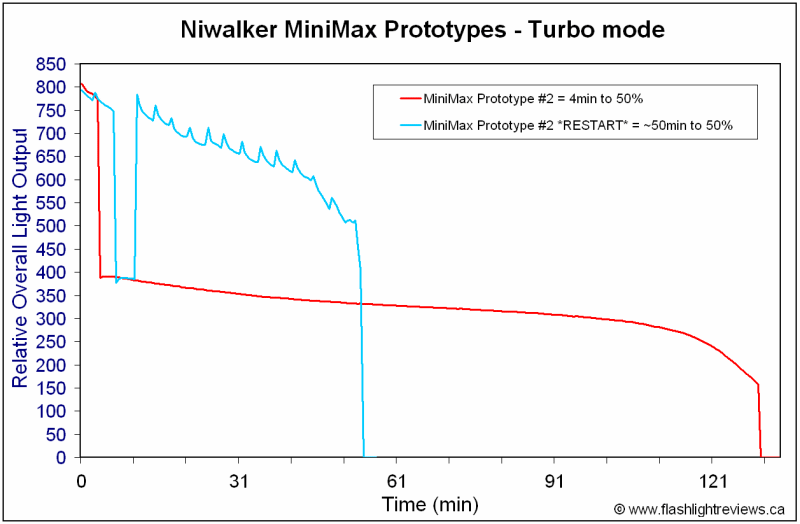
Note that I actually let the light cool for ~10 mins between each re-start (not shown on the time scale). I am only plotting above the time the light was actually on below, so that you can match up the time scale.
As you can see, the output keeps dropping over time, on successive re-starts. For example, after 30 mins,you are down to ~4000 estimated lumens, compared to ~5500 estimated lumens at the start. You also hit ~2000 lumens just before the light shuts-down completely, after ~50 mins. Sorry I can't be more accurate for time, as I accidentally let the light step-down for several minutes before one of the re-starts.
Potential Issues
Niwalker has been very responsive to my suggestions for improvement – please see my second prototype review for a summary of changes. Not everything I proposed has been implemented though, and there are still some outstanding potential issues that I can foresee:
You can now jump directly to Turbo from off in momentary mode. However, Turbo is still not available as part of the main memorized sequence when the light is locked on (i.e., you have to turn the light on first and then double-click for locked-on Turbo).
As before, pressing and holding switch when on jumps you to the lowest mode and then ramps up from there (i.e., still doesn't increase output from where you are).
I preferred the more visible and tactile stainless steel switch of the second prototype model. The final shipping version seems to have reverted to the original switch design.
The indicator LEDs under the switch logo are fairly bright (see my post #2 for a possible user solution).
The internal battery carrier has been considerably improved from the original design, but wider and longer high-capacity cells may still be a challenge to insert and remove. As before, no physical lock out is possible (unless you pull the cells), but an electronic lock-out is available.
The original handle design was located too close to the body to be functional, and this has been improved on the final version. However, the attachment screws are trickier to position than previously (although they are also less prominent, which is good if you don't plan to use the handle). Personally, I don't consider the handle necessary on a light this small – and you are better off holding it in your hand anyway (to gauge the heat level).
UPDATE JUNE 14, 2014: There are reports of wear occurring on the center strut of the battery carrier, at the insertion point where batteries go in. I recommend users carefully insert their cells into this light, and monitor the center strut for any signs of wear.
Preliminary Observations
UPDATE May 20, 2014: First off - my apologies again for the runtime output scale error on my second prototype review. The final graphs in this review are accurate for all my testing samples (including the second prototype).
This light has been a long way coming. Niwalker has taken their time over successive engineering samples to refine and develop the build and features of this light – based on my feedback, and from the members here. While no design will please everyone, I think this process has been invaluable in building a better product. :thumbsup:
Simply put, the MM15 is a flood monster in a tiny size. oo: This one of the smallest 4x18650 lights I have ever seen, and the one with the highest output. The use of two neutral white MT-G2 emitters has produced a true "wall of light" that should please wide spill fans. :bow:
oo: This one of the smallest 4x18650 lights I have ever seen, and the one with the highest output. The use of two neutral white MT-G2 emitters has produced a true "wall of light" that should please wide spill fans. :bow:
As you will see in my analysis above, I believe they have gotten this mostly right. There are still a few interface tweaks that I would have liked, but the light works well in its current form (which is expanded from the initial versions). Niwalker has come through on all their promised upgrades from the last prototype review, and even added one - a much thicker and "grippier" anodizing.
Personally, I recommend you carry the light without the handle, in order to gauge heat directly by touch. As with all high output lights, you should manually throttle down the output level if you find it is getting uncomfortable to hold. I should note that thermal step-down control is limited to the Turbo mode.
On that front, the use of a direct-drive-like circuit in this light makes sense – both to maximize runtime and minimize heat. The result is a light with excellent efficiency for the class - you get good runtimes on all levels (and with minimal intrusion of thermal step-down). Although most here seem to prefer constant output, direct-drive is more efficient - and you will not be able to notice the gradual drop-off in output as the cells drain.
Now that this much anticipated light is finally shipping, I look forward to hearing more from the members here. :wave:
P.S.: I am currently waiting on some modified versions of this light from Vinh Nguyen, and will publish a new review when they arrive.
EDIT: Here's the review of the dome-on and dedome versions of the MM15vn.
----
MiniMax Nova MM15 was provided by Niwalker for review.
Reviewer's note: This is the final shipping version of the MiniMax Nova MM15 by Niwalker. This review is meant to replace the earlier first prototype and second prototype reviews. Please continue all discussion in this thread, thanks!



The MM15 is meant to be a "floody" style powerhouse light, in a small handhold build (2xMT-G2 emitters, powered by 4x18650).
As before, there have some noticeable build changes from the previous engineering sample of the MM15. Basic design remains largely unchanged though. I will walk you through all the changes since my second prototype review, but first the official specs.
Manufacturer Reported Specifications:
(note: as always, these are simply what the manufacturer provides – scroll down to see my actual testing results).
- LED: Utilizes two U.S. made top binned Cree MT-G2 P0 LED chip
- Light output / runtime: Mode 1 : 6 lumens, Mode 2: 180 lumens, Mode 3: 450 lumens / 24 hrs, Mode 4: 880 lumens / 9 hrs 25 mins, Mode 5: 1950 lumens / 5 hrs 17mins, Turbo: 5233 lumens / 2 hrs 10 mins
- Max beam distance: 280 meters
- Peak beam intensity: cd: 19.600
- Highly efficient circuit design offers maximum output and runtime
- Multi-function clicky side switch with momentary activation and on/off
- Memory function to remember last output setting used (except hidden modes)
- Advanced thermal protection circuit prevents overheating
- Light orange peel reflector creates great throw distance and beam pattern
- Aircraft grade aluminum, mil-spec hard anodized for maximum wear
- Toughened ultra-clear tempered glass lens with anti-reflective coating
- Large cooper heat sink pad for superior thermal conductivity
- LED indicator turns red to alert user to switch lower output mode and recharge batteries in time
- Waterproof: To IPX-8 standard
- Impact resistance: 1.5M
- Batteries: four 18650 rechargeable batteries (not included)
- Dimensions: 114mm (length) x 64mm (head diameter)
- Weight: 360g (without battery)
- Included accessories: Lanyard, Holster, Spare o-rings,
- MSRP: $180

Retail packaging is similar to other recent Niwalker lights. Inside the hard cardboard box, you will find the light inside a decent quality holster (with Velcroed closing flap). The carry handle is included separately, in a cardboard holder. Also included are good quality hex-head stainless steel screws for the handle, Allen (hex) key, wrist lanyard, extra o-ring, warranty card and manual.



From left to right: AW Protected 18650 2200mAh; Niwalker MiniMax Nova MM15 shipping, prototype #1; Foursevens MMU-X3; Eagletac SX25L3; Niwalker BK-FA01.
Revised from the last prototype is an improved removable handle, which now has enough space to allow you to hold the light.






Personally, I don't really think the handle is necessary – the light is small enough to fit into your hand comfortably, and you are better off gauging the heat level by touch anyway.
All dimensions directly measured, and given with no batteries installed (unless indicated), and without the handle:
MiniMax Nova MM15 Shipping: Weight: 333.7g (without handle), 355.9g (with handle), (539g with 4x18650 and handle), Length: 114.6mm, Weight (bezel): 63.7mm
MiniMax Nova MM15 Prototype #2: Weight (with handle): 332.7g (516g with 4x18650), Length: 115.3mm, Weight (bezel): 60.7mm
MiniMax Nova MM15 Prototype #1: Weight: 268.3g (452g with 4x18650), Length: 114.0mm, Weight (bezel): 58.0mm
Eagletac SX25L3 3x18650: Weight: 315.9g, Length: 150.2mm, Weight (bezel): 47.0mm
[Crelant 7G10: Weight 643.4g (827g with 4x18650), Length: 198mm, Width (bezel): 79.0mm
Fenix TK75: Weight: 516.0g (700g with 4x18650), Length: 184mm, Width (bezel): 87.5mm
Nitecore TM11: Weight: 342.6g (476g with 8xCR123A), Length 135.3mm, Width (bezel): 59.5mm
Niwalker BK-FA01: Weight: 687.6g (870g with 4x18650), Length: 209mm, Width (bezel): 80.0mm, Width (tailcap): 50.3mm
Thrunite TN35 (MT-G2): Weight: 571.4g (723g with 3x18650), Length: 201mm, Width (bezel): 78.9mm









Build has been updated from the previous engineering sample, although overall size and dimensions are not very different from the second prototype. The most obvious change is in the anodizing – it is much thicker now, with a more "grippy" matte finish. It reminds me a lot of the Armytek anodizing. Note that this sort of finish with mark easily, but is much better to enhance grip.
Design of the body cover has changed as well, with some areas of actual knurling now (though it is not very aggressive). There are a number of model labels on the body tube now, bright white against the background. As before, this body tube is only a protective cover – there is an integrated battery carrier built into the head. Threading has changed slightly from earlier prototype; there are fewer threads now.
No lock-out is possible, due to the integrated carrier. The integrated battery carrier has been updated from the last version, with an improved design allowing easier access to the cells. Height of the built-in carrier is good, and most cells should fit (although really long or wide high-capacity cells may be a challenge to get in or out). As before, the four 18650 cells are in series, not parallel (i.e., 4s1p). See my analysis below for user interface changes.
Another major change is in the design of the removable handle. The handle has been raised appropriately, and the screw attachment points shrunken in size and recessed into the head. This is a better setup whether you plan to use the handle or not (i.e., less conspicuous screws now, and proper finger clearance). But it does make it hard to attach or remove.
As with the last engineering sample, there is also a lanyard attachment point and a reinforced tripod attachment point in the head. The switch is appropriately located directly in front of the handle, with an all-black button cover surround (and a "N" logo with green/red LEDs underneath). Note that the surround was stainless steel on the previous engineering sample - the final shipping version seems to have reverted to the original prototype model I reviewed. :shrug: Switch traverse/feel is pretty much unchanged across the versions, and about typical for an electronic switch. For those concerned about the brightness of the indicator button, see my post #2.
Let's take a look at the business end of the light, starting with the the MM15 Prototype #1:

And then the MM15 Prototype #2:

And now the final shipping version of the MM15:



As before, the MiniMax runs off two MT-G2 emitters in relatively shallow reflector wells. The reflector wells are a "light orange peel (LOP)" finish, compared to the heavily textured first prototype. It is still very much a flood light (scroll down for beam shots).
With the stainless steel bezel ring, the head and reflector have a quality appearance on the final shipping version. :thumbsup:
Note that as always, the MT-G2 emitter only comes in a variety of relatively neutral-warm tint bins (i.e., the coolest one available is 5000K). All the MT-G2 samples I've seen have certainly been in the typical "Neutral White" ~4000-5000K range, and this model is no exception.
Scroll down for beamshot comparisons.
User Interface
The user interface has been updated slightly from the last prototype.
As before, turn the light on/off by the electronic switch. There is now a momentary mode – press and hold the switch for momentary Turbo output. Alternatively click the switch (i.e., press and release) and the light comes on in constant output.
As before, once On, press and hold the switch to cycle through all the regular modes in sequence: 1 > 2 > 3 > 4 > 5. I would consider these as Ultra-lo > Lo > Med > Hi > Higher. Release the switch to select the desired level. You can restart the level ramp at any time, but the ramp always starts at Level 1 (i.e., ultra-lo). Note that as before, Turbo is not on the regular mode sequence (i.e., think of it as level 6).
The shipping MM15 has mode memory for the regular non-Turbo modes, and returns to last setting used from off.
Double-click from On to access Turbo. Double-click repeatedly for the strobe modes, in the following repeating sequence: Turbo > Strobe > SOS > Beacon. Note there is no mode memory for Turbo or the strobe modes.
You can access Strobe directly from Off now, by double-clicking switch. This means that you can have the light come on in Turbo or Strobe at any time.
There is an electronic lock-out mode, accessed by a rapid triple-click of the switch from Off. The two MT-G2 emitters will flash twice to indicate the lock-out is engaged. Another triple-click re-activates.
There is a standby indicator that flashes when the batteries are connected but the light is not on (i.e., a brief green flash of the "N" switch occurs exactly every four seconds on my sample). As before, the switch lights up in constant green when in use. The N changes to red as the cells near exhaustion – this is a warning to switch down to a lower level, as the light will shut-off automatically soon (due to an internal shut-down feature in the circuit). I provide details on this in my testing below. You can re-activate after the light shuts down, by pulling one of the cells out and re-installing.
For those concerned about the brightness of the indicator button, see my post #2.
Video:
For more information on the overall build and user interface, please see my video overview:
As with all my videos, I recommend you have annotations turned on. I commonly update the commentary with additional information or clarifications before publicly releasing the video.
PWM/Strobe
Reviewer's note: I have recently updated my oscilloscope software, so the traces below may look a little different from my earlier reviews.
As before, there is no sign of PWM that I can see, at any output level – I believe the MiniMax is current-controlled.
Noise:

As before, there is some noise is the high kHz range on the L2 through L5 levels (i.e., not on Moonlight or Turbo). It is quite common to see high frequency noise in current-controlled lights. Consistent with my standard review policy, I report on anything I can detect on a light. Rest assured, these signals are not visible to the eye in actual use – the light is fully flicker-free in all modes.
Strobe:

The strobe mode was a fairly typical 12Hz fast strobe (up from 10 Hz on the prototypes).
SOS:

A fairly typical SOS mode is included.
Beacon:
The new beacon mode on the shipping version is a half-second pulse of light, repeated every 2.5 secs (i.e., 4 pulses in 10 secs, as shown above).
Standby Drain
A standby current drain is inevitable on this light, due to the electronic switch. Despite how the carrier looks, the batteries are actually all in series, as before (i.e. 4s1p arrangement).
On the shipping sample I measured this as 460uA initially, but it rapidly drops down over 30 secs or so to settle at 370uA. This is reasonably low.
However, the standby indicator flash every three seconds causes a jump in current to 4.8mA when it is lit (on the shipping sample). If we use ~1.5mA as a rough overall average current (i.e., averaging the current over 4 secs), that would give you 2 and a half months before 3100mAh cells would be exhausted.
As before, there is no physical lock-out available (i.e., you would need to pull one of the cells). But Niwalker has added an electronic lock-out mode (triple-click the switch from off).
I have measured the current in lock-out mode, and it is no lower than the stable standby drain (i.e., 370uA). However, the standby indicator no longer flashes, and the light cannot be activated accidentally. So, in this lock-out mode, except almost a full year before 3100mAh cells would be fully drained.
FYI, in terms of the "N" logo indicator switch, I previously observed that the indicator LED goes red once the cells drop below ~3.45V when run the L5 level, ~3.40V on the L4 level, ~3.35V on the L3 level, ~3.30V on the L2 level. This gives you a reasonable amount of advance notice that it is time to change the batteries. :wave:
Beamshots:
And now, what you have all been waiting for.
Automatic white balance is used on most of my wall beamshots (to minimize tint differences), but in this case I went with a Daylight WB on my Canon for the MiniMax prototypes.
Note the second generation prototype is labelled "MiniMax #2 Proto", and the final shipping sample is labelled as "MM15 ship 2xMT-G2".
















Note: No matter what white balance I use, these comparisons will never be entirely accurate for tint. In real life, I find my MT-G2 lights all to be relatively neutral white, without a huge difference between them.
As before, the MM15 has an unbelievable amount of output on Turbo. Hard to directly compare, but my ceiling bounce results tell me that my final shipping sample is intermediate in output to my two previous prototypes.
Since the beam profile really hasn't changed from the second prototype, I've stuck with the indoor comparisons from that review. For your reference, the back of the couch is about 7 feet away (~2.3m) from the opening of the light, and the far wall is about 18 feet away (~5.9m). Below I am showing a couple of exposures, to allow you to better compare hotspot and spill. And again, the camera is set to a Daylight white balance for all lights below.



Again, these are all done with a Daylight white balance, to better show tint differences. But a single white balance will never capture the true difference between lights – in practice, the X6 is not that cool, and the MM15s are not that warm. :shrug:
Despite how it may seem, the MM15 is really a pure flood light. Scroll down for actual output and throw measures.
For outdoor shots, I'm waiting on a couple of modified MM15vn samples from Vinh Nguyen – I will be heading to take new pics as soon as they arrive. In the interim, here are the outdoor beamshots from my prototype reviews (the beam pattern is basically unchanged). As always, these are done in the style of my earlier 100-yard round-up review. Please see that thread for a discussion of the topography.


Given that this location was picked to illustrate relative throw (which the MM15 is not designed for), it doesn't really capture the overall brightness of this light very well – recommend you stick with the indoor basement shots for now.
That said, you can get a few hints of its relative brightness if you examine the far right end of the zoomed-out shots above (i.e., the tree line in the distance on the right). Depending on your monitor calibration, you may be able to faintly make the trees there (which are more than 100 yards away). You'll note how much hard it is to see these on the comparator SX25L3 or X6.
Again, I plan to update these beamshots soon with the final shipping version and the modified light from Vinh Nguyen – check back for updates. But for now, the stock MM15 looks very much the same as what is shown above.
EDIT: For outdoor beamshots comparing the stock MM15 to the dome-on and dedome versions of the modded MM15vn, please check out that new review.
Testing Method:
All my output numbers are relative for my home-made light box setup, as described on my flashlightreviews.ca website. You can directly compare all my relative output values from different reviews - i.e. an output value of "10" in one graph is the same as "10" in another. All runtimes are done under a cooling fan, except for any extended run Lo/Min modes (i.e. >12 hours) which are done without cooling.
I have devised a method for converting my lightbox relative output values (ROV) to estimated Lumens. See my How to convert Selfbuilt's Lightbox values to Lumens thread for more info.
Throw/Output Summary Chart:
My summary tables are reported in a manner consistent with the ANSI FL-1 standard for flashlight testing. Please see http://www.flashlightreviews.ca/FL1.htm for a discussion, and a description of all the terms used in these tables. Effective July 2012, I have updated all my Peak Intensity/Beam Distance measures with a NIST-certified Extech EA31 lightmeter (orange highlights).

Since my high-output lights don't fit in my lightbox, I am really relying on my ceiling bounce measures here. The second MM15 prototype was an outstanding performer, and my shipping sample is intermediate to the first and second prototypes. At ~5200-5500 lumens across the three samples, this is a clearly an outstanding output performer for the size. :bow:
Throw remains definitely pretty minimal, given the overall output of the MM15. As always, the MT-G2 produces a very smooth beam profile.
Let's see how the rest of the output levels compare, between the various samples.

Note that with the second prototype, Niwalker added a fifth regular mode – which is also the step-down level from Turbo. There is a very close match to my results across the various samples, and to Niwalker's reported specs.
Ever since the second prototype, Niwalker has been using thermal step-down from Turbo (as opposed to the timed step-down on the first prototype). See runtimes for more info.
Output/Runtime Graphs:
UPDATE MAY 20, 2014: First off, a MAJOR apology to all who have been following the development of this model. I accidentally mislabeled some of the runtimes in my testing of the second prototype review. Normally, that would only have been a minor error on the figure legend. But because the MM15 doesn't completely fit inside my lightbox, I do a calibration adjustment to get the right output scale. This means that the wrong adjustment was applied to several of the prototype #2 runtimes, giving the wrong output level on the graphs.

I am truly sorry about this everyone. I am revised all the graphs below (and in the second prototype review). My thanks again to RedForest UK - it was his current drain data that helped me track down my error. :thumbsup:
As always, before I get started, my standard runtimes are done on AW protected 18650 2200mAh cells, under a cooling fan.
Let's start with the higher output modes of the new shipping MM15:

As before, the thermal sensor kicks the light down from Turbo to L5 after a few mins of continuous runtime. It took about 6 mins in the runtime above, which was done under fan cooling. Without cooling however, it would likely have stepped down within ~3 mins. As always, I don't recommend you rely on thermal sensors to control output – on super-high output lights like this, you should always be holding the light in your hand on the higher levels, to gauge relative heat and to allow you to turn down the light as necessary.
Let's see how the final shipping version compares to the previous prototypes:





Now that I have fixed my glitch from the second prototype review, you can see that performance is basically unchanged from the earlier prototypes. This makes a lot more sense now, based on the output/current draw results. Unfortunately, I missed the L5 runtime on the second prototype sample, and no longer have this prototype to re-test (it was sent to Vinh Nguyen for mod testing, and didn't survive the experience).
In case you are wondering how higher capacity cells might fare, here is a comparison of the L4-L6 modes run on NCR18650A 3100mAh cells:



In addition to greater runtime, these cells were also able to keep the output mode slightly more stable at the higher L5 and Turbo settings (at least in the beginning). This means you get brighter light for longer on these levels. On L4, the real advantage was in extended runtime (for comparable output).
FYI, Niwalker reports that they got 4+ hours runtime on L5 with 3400mAh batteries before manually stopping the test (while the light was still fairly bright, all cells >3.19V).
I am waiting on a couple of modified MM15vn samples from Vinh, and will update this review once I see how they perform. :wave: EDIT:The review of the modded MM15vn samples is now up.
Let's see how the MM15 compares to other MT-G2 lights in my collection.


Again, these results make more sense now that I've corrected my output curves. Basically, overall efficiency of the MM15 is identical to the Niwalker BKFA02, at all comparable levels. Even though there are two emitters the MM15, it isn't providing any real efficiency advantage over the BKFA02. But due to the largely direct-drive like pattern, these two Niwalker lights remain the most efficient MT-G2 lights in m collection at the moment.
Of course, a lot of that has to do with the fact that the Niwalker lights are direct-drive on all modes. I have also queried this with Niwalker, and they respond that this is intentional: the MM15 in particular is not designed to have flat regulation, as this would likely result in overheating issues. They actually experimented with a constant-current circuit, but found the light got too hot on L5 and L6. In contrast, they report the light was always comfortable to use by hand outdoors when a direct-drive circuit was installed. Further, they point out that with this circuit in place, there is no visible step down required – and you will get a lot more runtime than with constant output.
I certainly agree with all these points, and think this was indeed the best practical solution to provide high initial outputs and sustained runtimes.
In response to some questions in my earlier prototype review, I did some additional testing of repeated restarts of the second prototype in Turbo mode. Given the identical performance of my shipping sample, I haven't bothered to repeat these tests – here is what I previously reported:

Note that I actually let the light cool for ~10 mins between each re-start (not shown on the time scale). I am only plotting above the time the light was actually on below, so that you can match up the time scale.
As you can see, the output keeps dropping over time, on successive re-starts. For example, after 30 mins,you are down to ~4000 estimated lumens, compared to ~5500 estimated lumens at the start. You also hit ~2000 lumens just before the light shuts-down completely, after ~50 mins. Sorry I can't be more accurate for time, as I accidentally let the light step-down for several minutes before one of the re-starts.
Potential Issues
Niwalker has been very responsive to my suggestions for improvement – please see my second prototype review for a summary of changes. Not everything I proposed has been implemented though, and there are still some outstanding potential issues that I can foresee:
You can now jump directly to Turbo from off in momentary mode. However, Turbo is still not available as part of the main memorized sequence when the light is locked on (i.e., you have to turn the light on first and then double-click for locked-on Turbo).
As before, pressing and holding switch when on jumps you to the lowest mode and then ramps up from there (i.e., still doesn't increase output from where you are).
I preferred the more visible and tactile stainless steel switch of the second prototype model. The final shipping version seems to have reverted to the original switch design.
The indicator LEDs under the switch logo are fairly bright (see my post #2 for a possible user solution).
The internal battery carrier has been considerably improved from the original design, but wider and longer high-capacity cells may still be a challenge to insert and remove. As before, no physical lock out is possible (unless you pull the cells), but an electronic lock-out is available.
The original handle design was located too close to the body to be functional, and this has been improved on the final version. However, the attachment screws are trickier to position than previously (although they are also less prominent, which is good if you don't plan to use the handle). Personally, I don't consider the handle necessary on a light this small – and you are better off holding it in your hand anyway (to gauge the heat level).
UPDATE JUNE 14, 2014: There are reports of wear occurring on the center strut of the battery carrier, at the insertion point where batteries go in. I recommend users carefully insert their cells into this light, and monitor the center strut for any signs of wear.
Preliminary Observations
UPDATE May 20, 2014: First off - my apologies again for the runtime output scale error on my second prototype review. The final graphs in this review are accurate for all my testing samples (including the second prototype).
This light has been a long way coming. Niwalker has taken their time over successive engineering samples to refine and develop the build and features of this light – based on my feedback, and from the members here. While no design will please everyone, I think this process has been invaluable in building a better product. :thumbsup:
Simply put, the MM15 is a flood monster in a tiny size.
As you will see in my analysis above, I believe they have gotten this mostly right. There are still a few interface tweaks that I would have liked, but the light works well in its current form (which is expanded from the initial versions). Niwalker has come through on all their promised upgrades from the last prototype review, and even added one - a much thicker and "grippier" anodizing.
Personally, I recommend you carry the light without the handle, in order to gauge heat directly by touch. As with all high output lights, you should manually throttle down the output level if you find it is getting uncomfortable to hold. I should note that thermal step-down control is limited to the Turbo mode.
On that front, the use of a direct-drive-like circuit in this light makes sense – both to maximize runtime and minimize heat. The result is a light with excellent efficiency for the class - you get good runtimes on all levels (and with minimal intrusion of thermal step-down). Although most here seem to prefer constant output, direct-drive is more efficient - and you will not be able to notice the gradual drop-off in output as the cells drain.
Now that this much anticipated light is finally shipping, I look forward to hearing more from the members here. :wave:
P.S.: I am currently waiting on some modified versions of this light from Vinh Nguyen, and will publish a new review when they arrive.
EDIT: Here's the review of the dome-on and dedome versions of the MM15vn.
----
MiniMax Nova MM15 was provided by Niwalker for review.
Last edited:


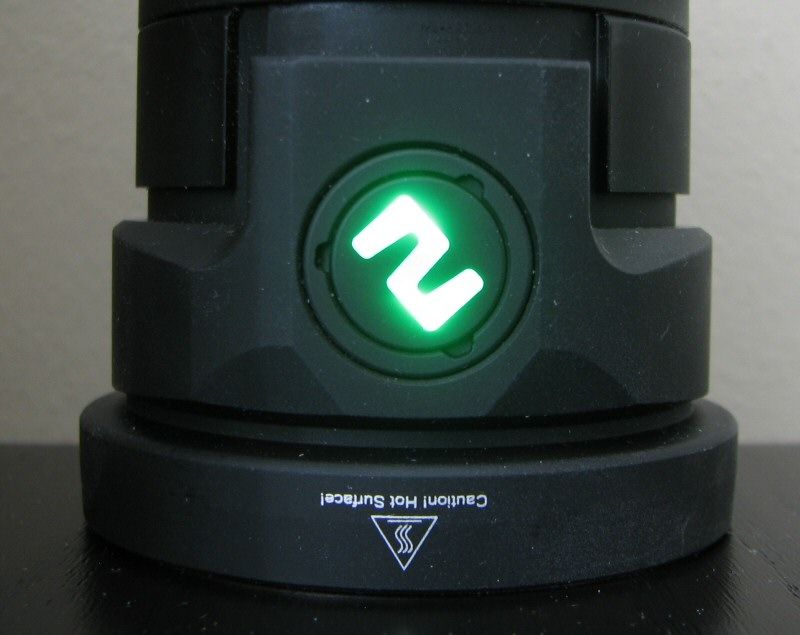
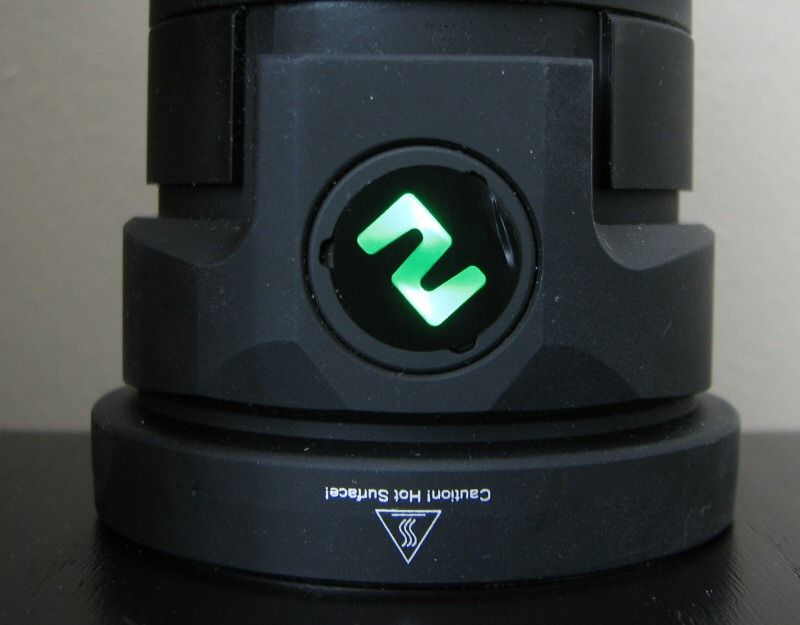
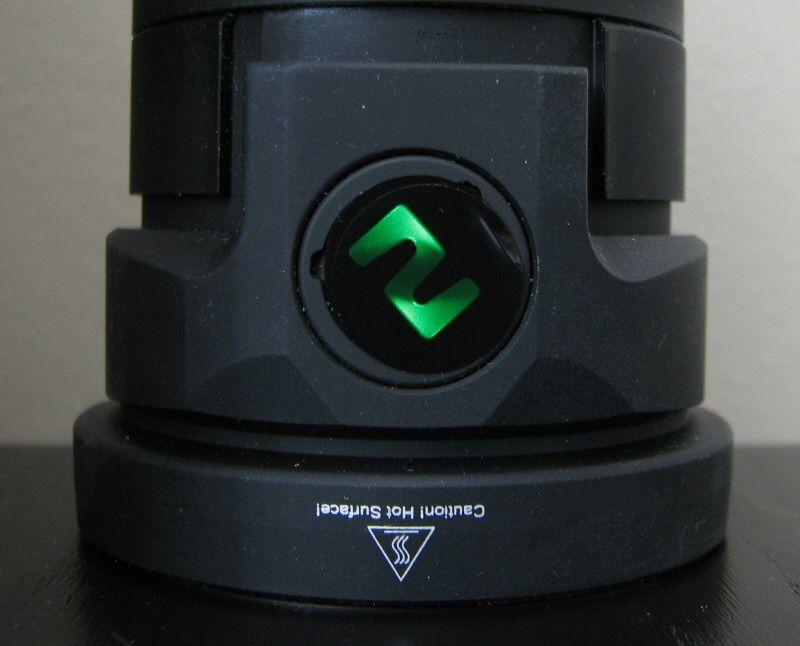
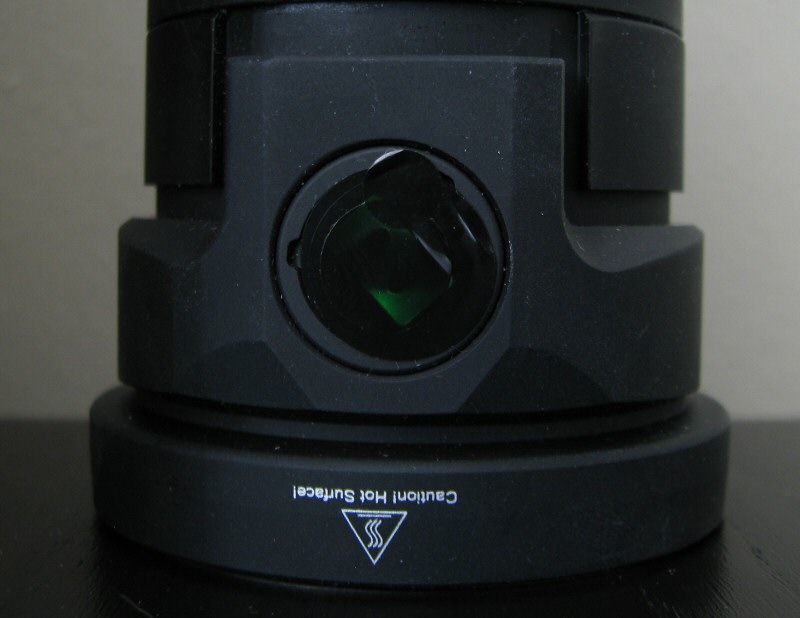
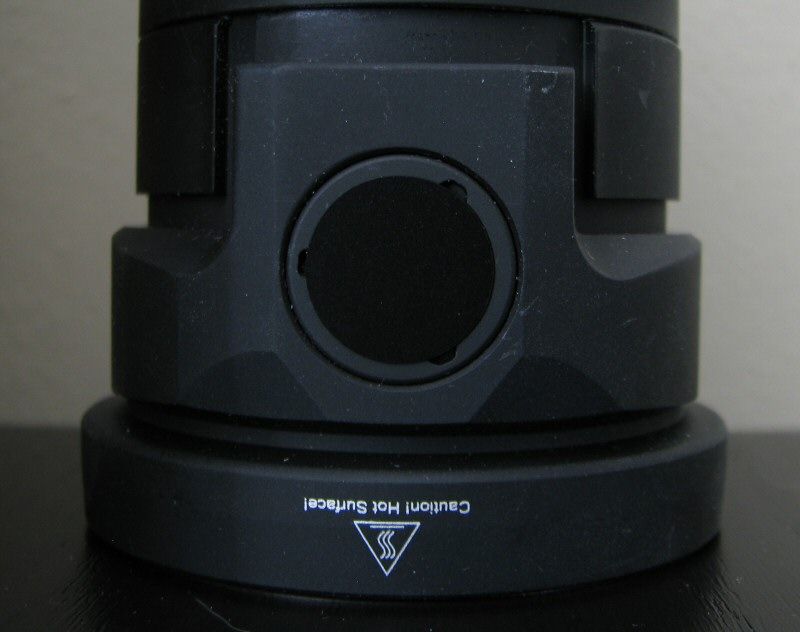










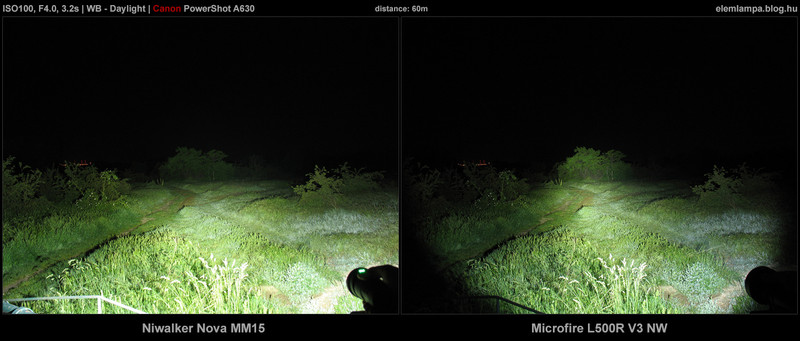









 After our exchange last night, I came to the same suspicion that some sort of shift may have occurred. I have reviewed all the data this morning, and found out what has happened - there was a shift on the L2-L4 runtimes of the second prototype (i.e., they were reported as L3-L5 in error, using the wrong calibration). The error was perpetuated on the shipping tests, as I was using the same templates to structure the review (all except the L5, where I correctly built the graph off the correct L6 template).
After our exchange last night, I came to the same suspicion that some sort of shift may have occurred. I have reviewed all the data this morning, and found out what has happened - there was a shift on the L2-L4 runtimes of the second prototype (i.e., they were reported as L3-L5 in error, using the wrong calibration). The error was perpetuated on the shipping tests, as I was using the same templates to structure the review (all except the L5, where I correctly built the graph off the correct L6 template).